Stable amplitude chimera states and chimera death in repulsively coupled chaotic oscillators
阅读
下载地址:
复现
figure 1
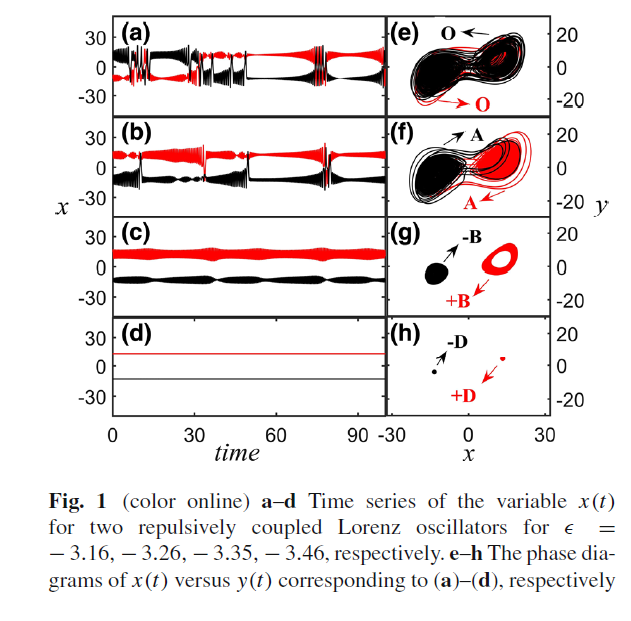
module Lorenz
implicit none
real,parameter :: h=0.001
integer,parameter :: MaxT=2500000,T_trans=2000000,N=3,M=2
real(kind=8) :: x(M,N)
integer :: p=1
integer,allocatable :: neighbour_matrix(:,:)
contains
subroutine x0()
implicit none
integer :: i
real :: x1,x2,x3
call random_seed()
do i=1,M,1
call random_number(x1)
call random_number(x2)
call random_number(x3)
x(i,1)=31.0*x1-14.0
x(i,2)=44.0*x2-20.0
x(i,3)=23.0*x3-1
write(20,*) x(i,1),x(i,2),x(i,3)
end do
end subroutine x0
subroutine fnf(xx,fx,i)
implicit none
real(kind=8) :: xx(N),fx(N)
integer :: t,j,i
real(kind=8) :: a,b,c,coupling,epsilon
coupling=0.0
epsilon=-3.16
do j=1,M,1
coupling=coupling+neighbour_matrix(i,j)*(x(j,1)-x(i,1))
end do
a=10.0
b=2.0
c=28.0
fx(1)=a*(xx(2)-xx(1))+(epsilon/real(p))*coupling
fx(2)=c*xx(1)-xx(1)*xx(3)-xx(2)
fx(3)=xx(1)*xx(2)-b*xx(3)
return
end subroutine fnf
subroutine rk4(x,t)
implicit none
integer :: i,j,t
real(kind=8) :: x(M,N),xx(N),fx(N)
real(kind=8) :: kx1(N),kx2(N),kx3(N),kx4(N)
do i=1,M,1
xx=x(i,:)
call fnf(xx,fx,i)
kx1=h*fx
xx=x(i,:)+0.5*kx1
call fnf(xx,fx,i)
kx2=h*fx
xx=x(i,:)+0.5*kx2
call fnf(xx,fx,i)
kx3=h*fx
xx=x(i,:)+kx3
call fnf(xx,fx,i)
kx4=h*fx
x(i,:)=x(i,:)+(kx1+2.0*kx2+2.0*kx3+kx4)/6.0
end do
return
end subroutine rk4
!max与min
subroutine Max_Min(xxx,max,min)
implicit none
real(kind=8) :: max(M),min(M),xxx(M)
integer :: i
do i=1,M,1
if(max(i)<xxx(i)) then
max(i)=xxx(i)
end if
if(min(i)>xxx(i)) then
min(i)=xxx(i)
end if
end do
return
end subroutine Max_Min
!建立网络矩阵
subroutine neighbour(K)
implicit none
integer :: K !单节点K个邻居
integer :: i,j,number
allocate(neighbour_matrix(M,M))
!初始化网络矩阵
neighbour_matrix=0
do i=1,M-1,1
do j=i+1,M,1
if(abs(i-j)<=K/2.or.abs(i-j)>=M-K/2) then
neighbour_matrix(i,j)=1
neighbour_matrix(j,i)=1
end if
end do
end do
!输出矩阵
do i=1,M,1
do j=1,M,1
write(10,"(I2)",advance='no') neighbour_matrix(i,j)
end do
write(10,*)
end do
return
end subroutine neighbour
end module Lorenz
program main
use Lorenz
implicit none
integer :: i,j,t
real(kind=8) :: max(M),min(M)
open(10,file="neighbour_matrix.txt")
open(20,file="x0.txt")
open(30,file="c_M_max_min.txt")
open(40,file="t_x_y_z_1.txt")
open(50,file="t_x_y_z_2.txt")
max=-1000.0
min=1000.0
call x0()
call neighbour(2*p)
do t=1,MaxT,1
call rk4(x,t)
if(t>T_trans) then
call Max_Min(x(:,1),max,min)
write(40,"(4(F15.6))") (t-T_trans)*h,x(1,1),x(1,2),x(1,3)
write(50,"(4(F15.6))") (t-T_trans)*h,x(2,1),x(2,2),x(2,3)
end if
end do
do j=1,M,1
write(30,*) j,max(j),min(j)
end do
end program mainfigure 1_A
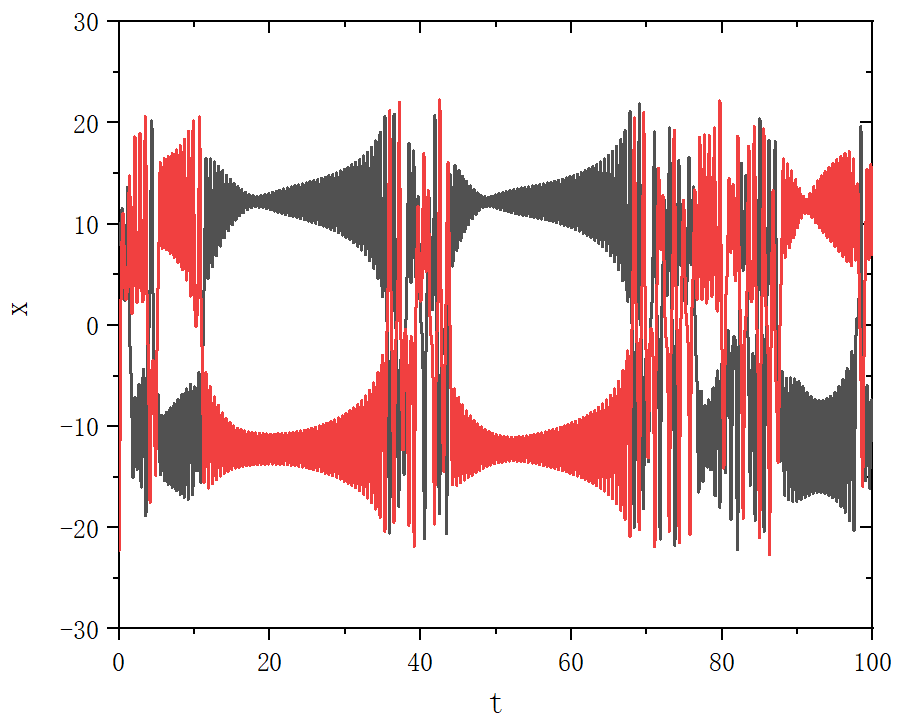
figure 1_B

figure 1_C

figure 1_D
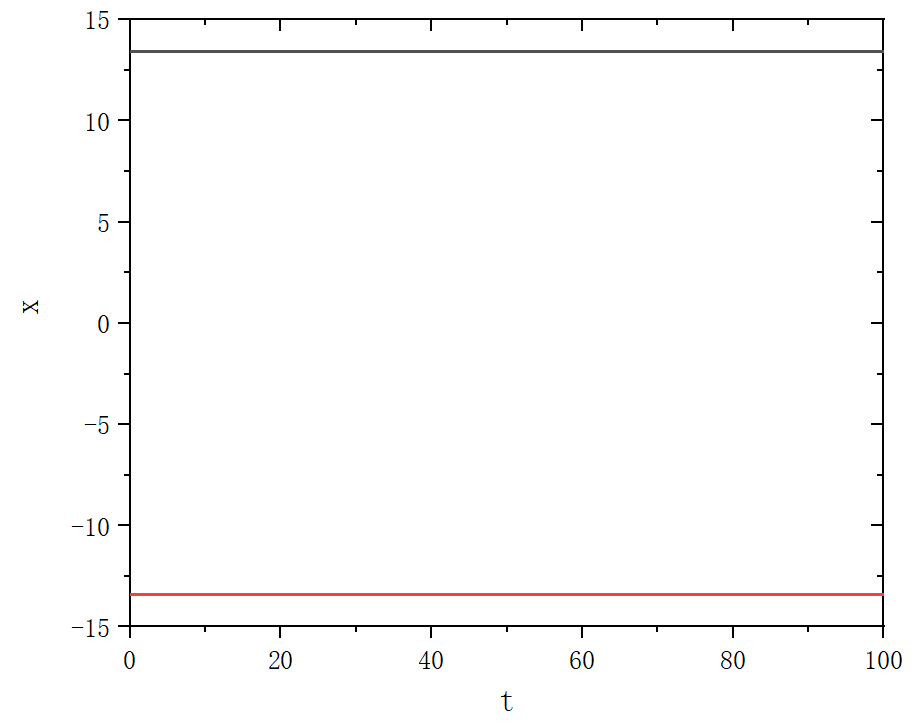
figure 1_E

figure 1_F
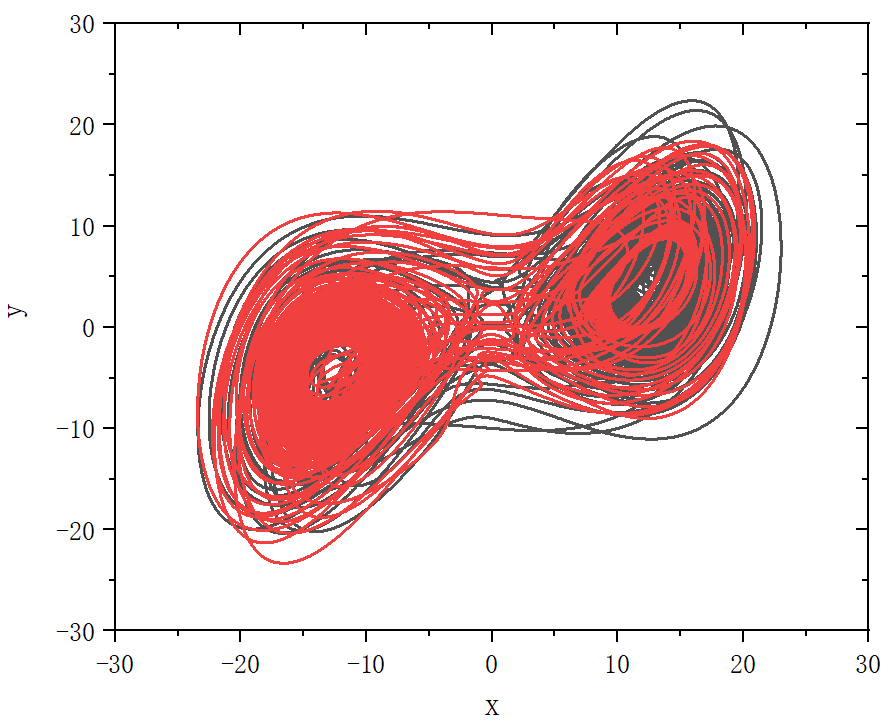
figure 1_G

figure 1_H
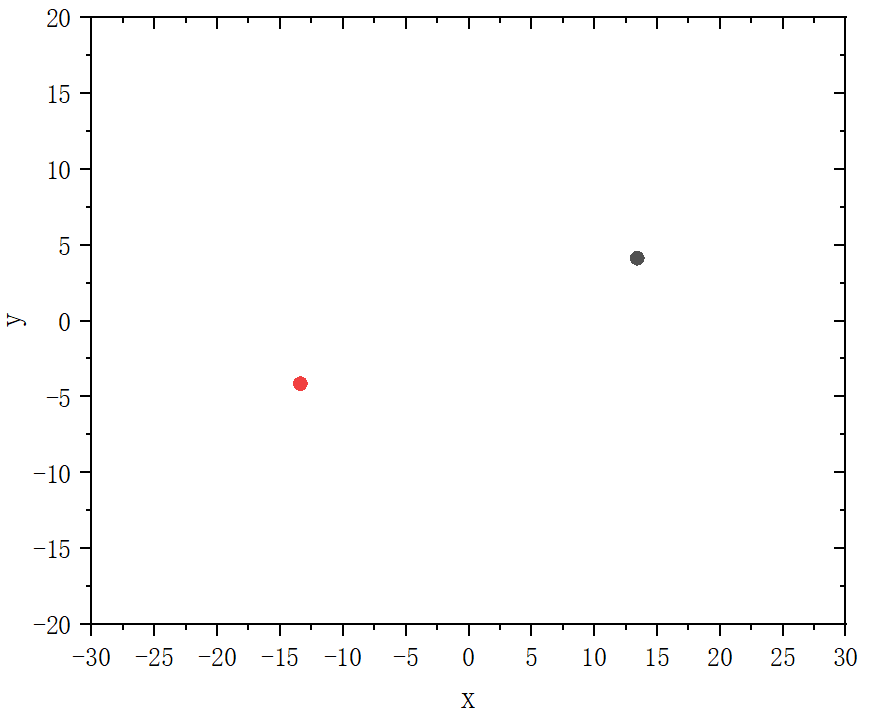
figure 2

module Lorenz
implicit none
real,parameter :: h=0.001
integer,parameter :: MaxT=2006000,T_trans=2003000,N=3,M=100
real(kind=8) :: x(M,N)
integer :: p=35
integer,allocatable :: neighbour_matrix(:,:)
contains
subroutine x0()
implicit none
integer :: i
real :: x1,x2,x3
call random_seed()
do i=1,M,1
call random_number(x1)
call random_number(x2)
call random_number(x3)
x(i,1)=31.0*x1-14.0
x(i,2)=44.0*x2-20.0
x(i,3)=23.0*x3-1
write(20,*) x(i,1),x(i,2),x(i,3)
end do
end subroutine x0
subroutine fnf(xx,fx,i)
implicit none
real(kind=8) :: xx(N),fx(N)
integer :: t,j,i
real(kind=8) :: a,b,c,coupling,epsilon
coupling=0.0
epsilon=-6.0
do j=1,M,1
coupling=coupling+neighbour_matrix(i,j)*(x(j,1)-x(i,1))
end do
a=10.0
b=2.0
c=28.0
fx(1)=a*(xx(2)-xx(1))+(epsilon/real(2.0*p))*coupling
fx(2)=c*xx(1)-xx(1)*xx(3)-xx(2)
fx(3)=xx(1)*xx(2)-b*xx(3)
return
end subroutine fnf
subroutine rk4(x,t)
implicit none
integer :: i,j,t
real(kind=8) :: x(M,N),xx(N),fx(N)
real(kind=8) :: kx1(N),kx2(N),kx3(N),kx4(N)
do i=1,M,1
xx=x(i,:)
call fnf(xx,fx,i)
kx1=h*fx
xx=x(i,:)+0.5*kx1
call fnf(xx,fx,i)
kx2=h*fx
xx=x(i,:)+0.5*kx2
call fnf(xx,fx,i)
kx3=h*fx
xx=x(i,:)+kx3
call fnf(xx,fx,i)
kx4=h*fx
x(i,:)=x(i,:)+(kx1+2.0*kx2+2.0*kx3+kx4)/6.0
end do
return
end subroutine rk4
!max与min
subroutine Max_Min(xxx,max,min)
implicit none
real(kind=8) :: max(M),min(M),xxx(M)
integer :: i
do i=1,M,1
if(max(i)<xxx(i)) then
max(i)=xxx(i)
end if
if(min(i)>xxx(i)) then
min(i)=xxx(i)
end if
end do
return
end subroutine Max_Min
!建立网络矩阵
subroutine neighbour(K)
implicit none
integer :: K !单节点K个邻居
integer :: i,j,number
allocate(neighbour_matrix(M,M))
!初始化网络矩阵
neighbour_matrix=0
do i=1,M-1,1
do j=i+1,M,1
if(abs(i-j)<=K/2.or.abs(i-j)>=M-K/2) then
neighbour_matrix(i,j)=1
neighbour_matrix(j,i)=1
end if
end do
end do
!输出矩阵
do i=1,M,1
do j=1,M,1
write(10,"(I2)",advance='no') neighbour_matrix(i,j)
end do
write(10,*)
end do
return
end subroutine neighbour
end module Lorenz
program main
use Lorenz
implicit none
integer :: i,j,t
real(kind=8) :: max(M),min(M)
open(10,file="neighbour_matrix.txt")
open(20,file="x0.txt")
open(30,file="c_M_max_min.txt")
open(40,file="t_x_y_z_1.txt")
open(50,file="t_x_y_z_2.txt")
open(60,file="i_t_x_y_z.txt")
max=-1000.0
min=1000.0
call x0()
call neighbour(2*p)
do t=1,MaxT,1
call rk4(x,t)
if(t>T_trans) then
call Max_Min(x(:,1),max,min)
write(40,"(4(F15.6))") (t-T_trans)*h,x(1,1),x(1,2),x(1,3)
write(50,"(4(F15.6))") (t-T_trans)*h,x(2,1),x(2,2),x(2,3)
do i=1,M,1
if(mod(t,1)==0) then
write(60,"(5(F15.6))") real(i),(t-T_trans)*h,x(i,1),x(i,2),x(i,3)
end if
end do
end if
end do
do j=1,M,1
write(30,*) j,max(j),min(j)
end do
end program mainfigure 2_A
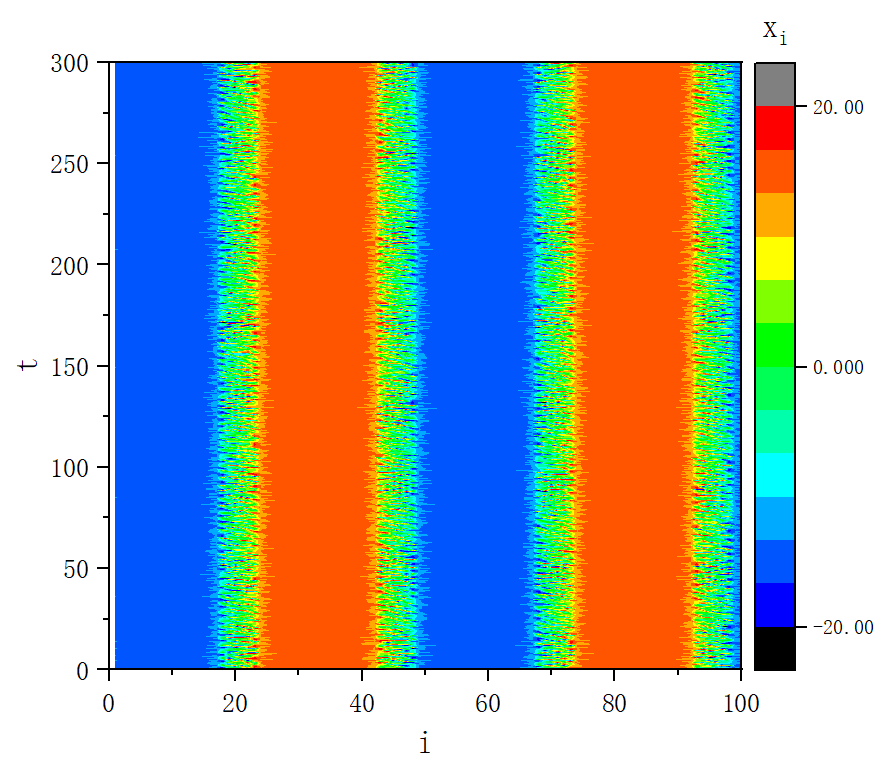

figure 2_B
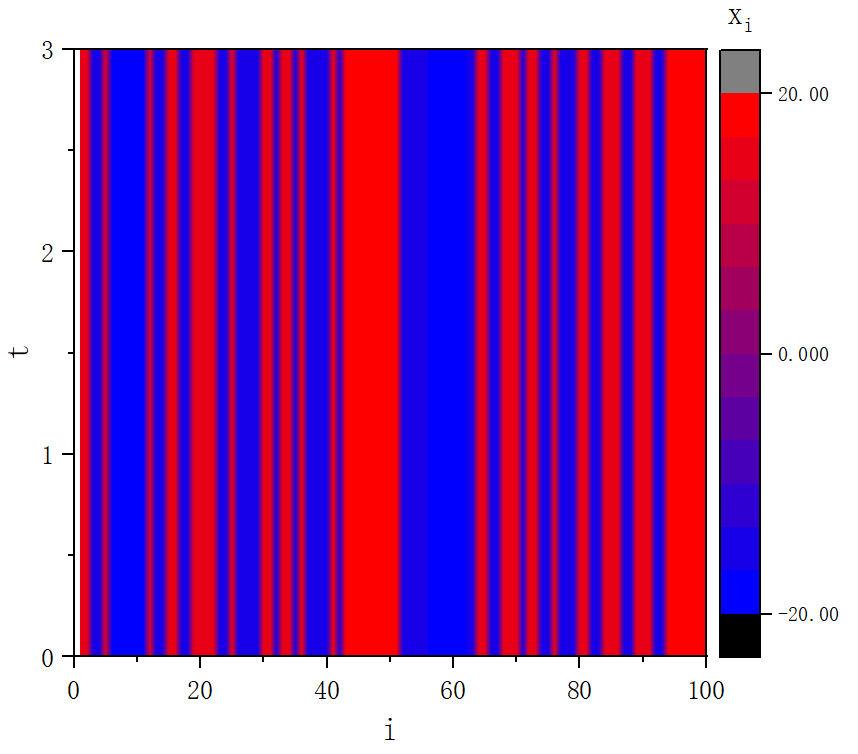
figure 2_C
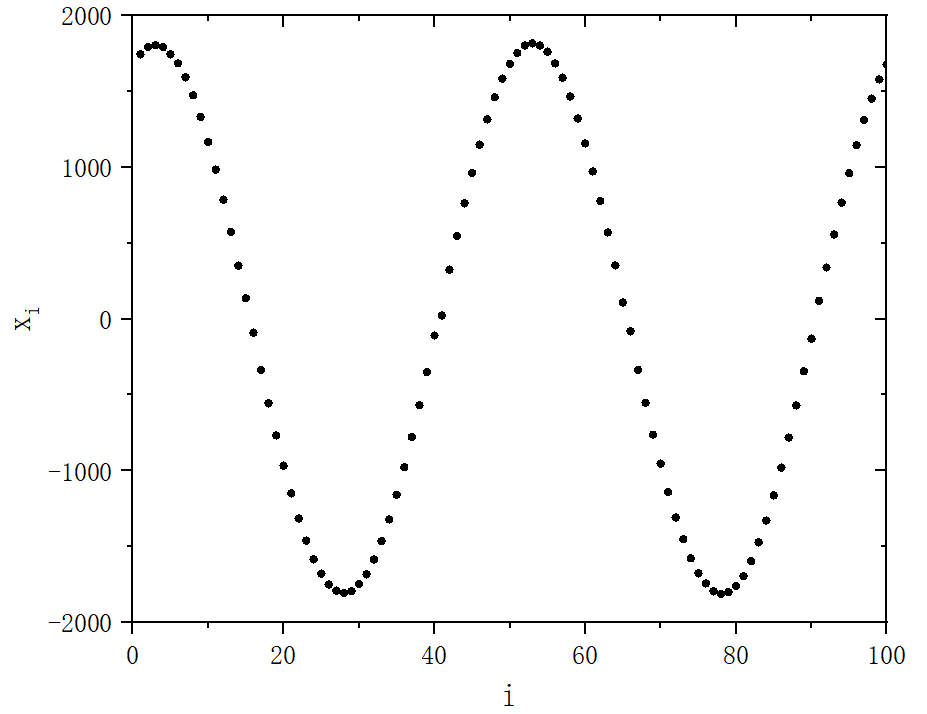
figure 2_D
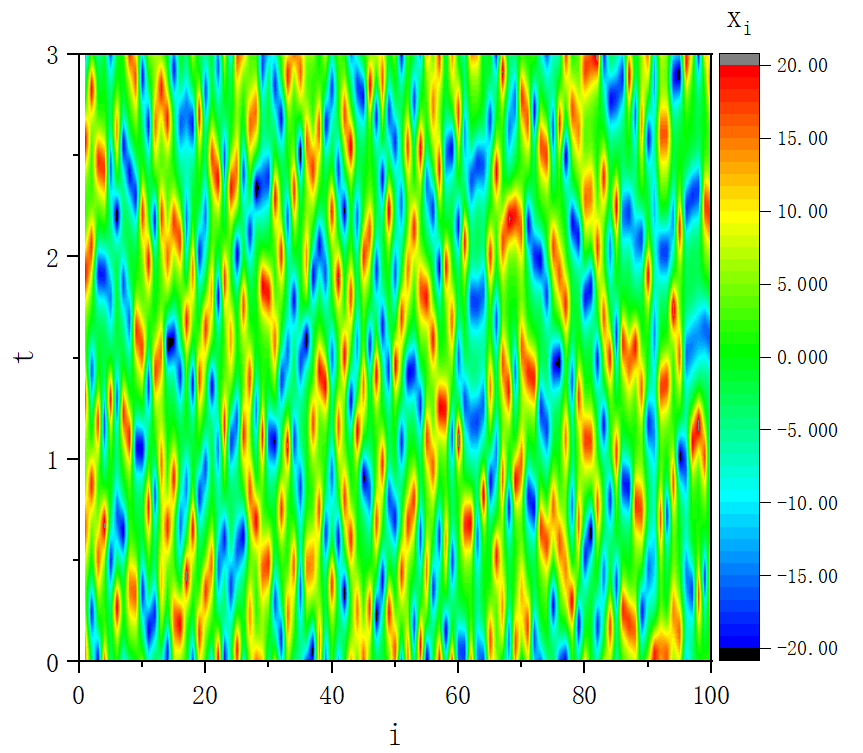
figure 2_E
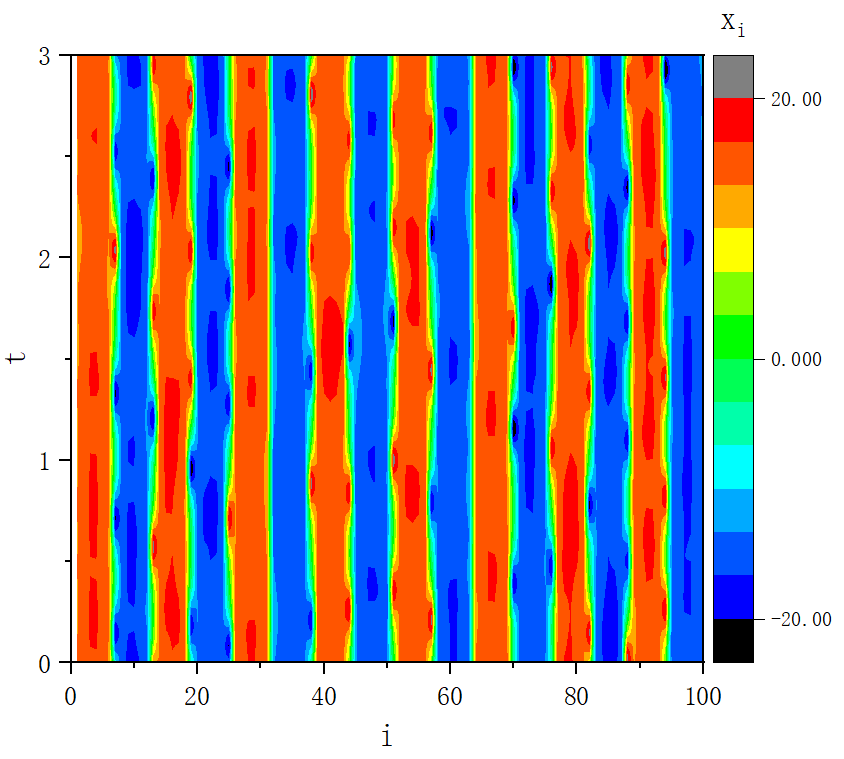
figure 2_F
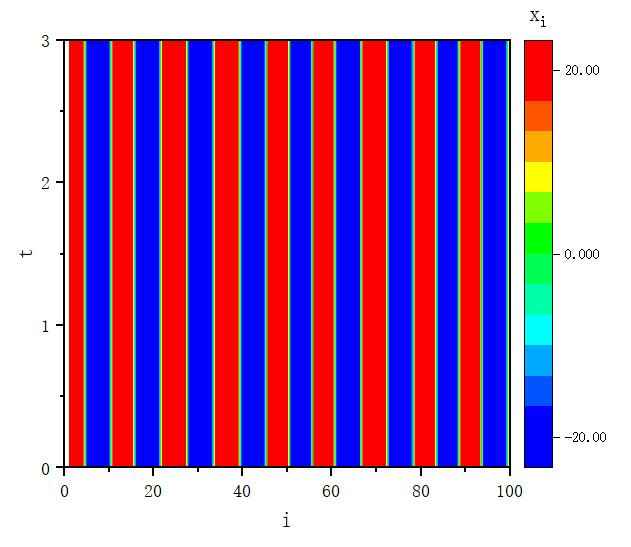
figure 3

module Lorenz
implicit none
real,parameter :: h=0.001
integer,parameter :: MaxT=2030000,T_trans=2000000,N=3,M=100
real(kind=8) :: x(M,N)
integer :: p=1
integer,allocatable :: neighbour_matrix(:,:)
contains
subroutine x0()
implicit none
integer :: i
real :: x1,x2,x3
call random_seed()
do i=1,M,1
call random_number(x1)
call random_number(x2)
call random_number(x3)
x(i,1)=31.0*x1-14.0
x(i,2)=44.0*x2-20.0
x(i,3)=23.0*x3-1.0
write(20,*) x(i,1),x(i,2),x(i,3)
end do
end subroutine x0
subroutine fnf(xx,fx,i)
implicit none
real(kind=8) :: xx(N),fx(N)
integer :: t,j,i
real(kind=8) :: a,b,c,coupling,epsilon
coupling=0.0
epsilon=-3.05
do j=1,M,1
coupling=coupling+neighbour_matrix(i,j)*(x(j,1)-x(i,1))
end do
a=10.0
b=2.0
c=28.0
fx(1)=a*(xx(2)-xx(1))+(epsilon/real(2.0*p))*coupling
fx(2)=c*xx(1)-xx(1)*xx(3)-xx(2)
fx(3)=xx(1)*xx(2)-b*xx(3)
return
end subroutine fnf
subroutine rk4(x,t)
implicit none
integer :: i,j,t
real(kind=8) :: x(M,N),xx(N),fx(N)
real(kind=8) :: kx1(N),kx2(N),kx3(N),kx4(N)
do i=1,M,1
xx=x(i,:)
call fnf(xx,fx,i)
kx1=h*fx
xx=x(i,:)+0.5*kx1
call fnf(xx,fx,i)
kx2=h*fx
xx=x(i,:)+0.5*kx2
call fnf(xx,fx,i)
kx3=h*fx
xx=x(i,:)+kx3
call fnf(xx,fx,i)
kx4=h*fx
x(i,:)=x(i,:)+(kx1+2.0*kx2+2.0*kx3+kx4)/6.0
end do
return
end subroutine rk4
!max与min
subroutine Max_Min(xxx,max,min)
implicit none
real(kind=8) :: max(M),min(M),xxx(M)
integer :: i
do i=1,M,1
if(max(i)<xxx(i)) then
max(i)=xxx(i)
end if
if(min(i)>xxx(i)) then
min(i)=xxx(i)
end if
end do
return
end subroutine Max_Min
!建立网络矩阵
subroutine neighbour(K)
implicit none
integer :: K !单节点K个邻居
integer :: i,j,number
allocate(neighbour_matrix(M,M))
!初始化网络矩阵
neighbour_matrix=0
do i=1,M-1,1
do j=i+1,M,1
if(abs(i-j)<=K/2.or.abs(i-j)>=M-K/2) then
neighbour_matrix(i,j)=1
neighbour_matrix(j,i)=1
end if
end do
end do
!输出矩阵
do i=1,M,1
do j=1,M,1
write(10,"(I2)",advance='no') neighbour_matrix(i,j)
end do
write(10,*)
end do
return
end subroutine neighbour
end module Lorenz
program main
use Lorenz
implicit none
integer :: i,j,t
real(kind=8) :: max(M),min(M)
open(10,file="neighbour_matrix.txt")
open(20,file="x0.txt")
open(30,file="c_M_max_min.txt")
open(40,file="t_x_y_z_14.txt")
open(50,file="t_x_y_z_15.txt")
open(60,file="i_t_x_y_z.txt")
open(70,file="i_t_x_y_z_kuaizhao.txt")
max=-10000.0
min=10000.0
call x0()
call neighbour(2*p)
do t=1,MaxT,1
call rk4(x,t)
if(t>T_trans) then
call Max_Min(x(:,1),max,min)
write(40,"(4(F15.6))") (t-T_trans)*h,x(14,1),x(14,2),x(14,3)
write(50,"(4(F15.6))") (t-T_trans)*h,x(15,1),x(15,2),x(15,3)
do i=1,M,1
if((t-T_trans)*h==20) then
write(70,"(5(F15.6))") real(i),(t-T_trans)*h,x(i,1),x(i,2),x(i,3)
end if
if(mod(t,50)==0) then
write(60,"(5(F15.6))") real(i),(t-T_trans)*h,x(i,1),x(i,2),x(i,3)
end if
end do
end if
end do
do j=1,M,1
write(30,*) j,max(j),min(j)
end do
end program mainfigure 3_A

figure 3_B
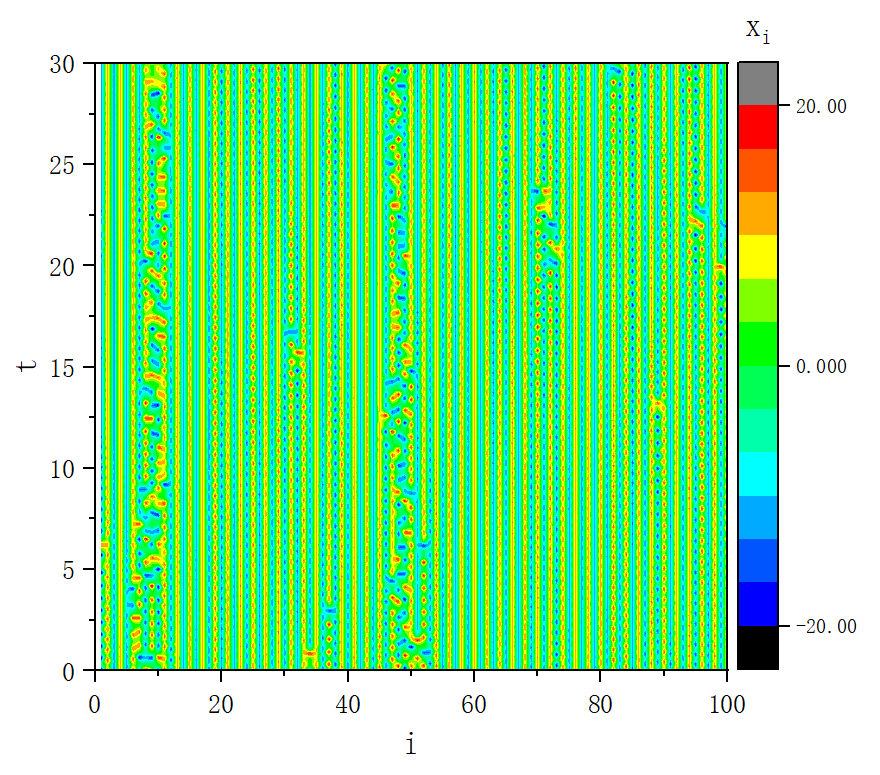
figure 3_C
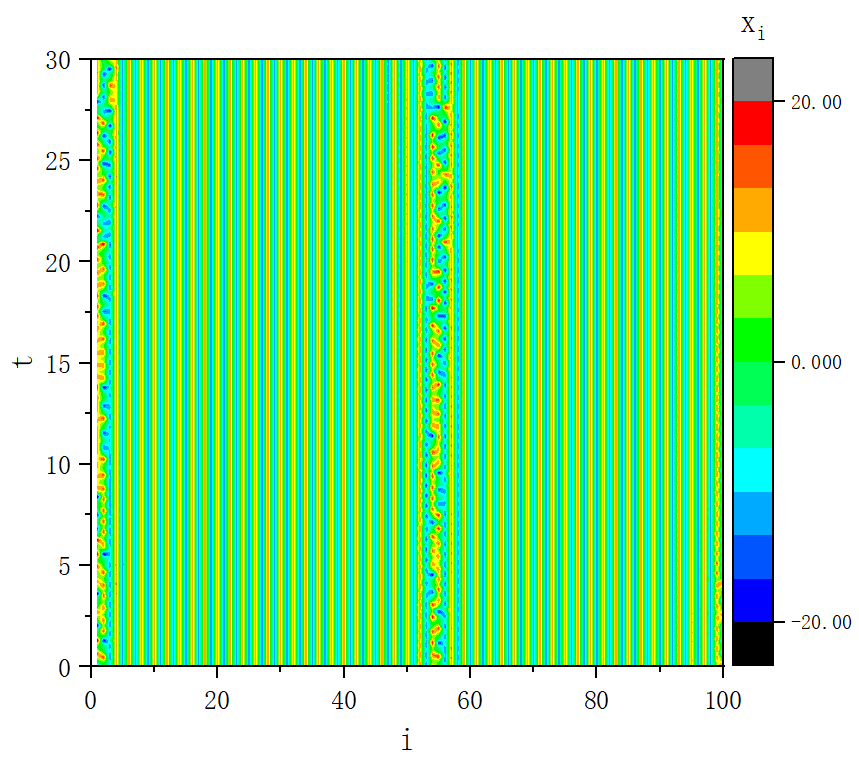
figure 3_D
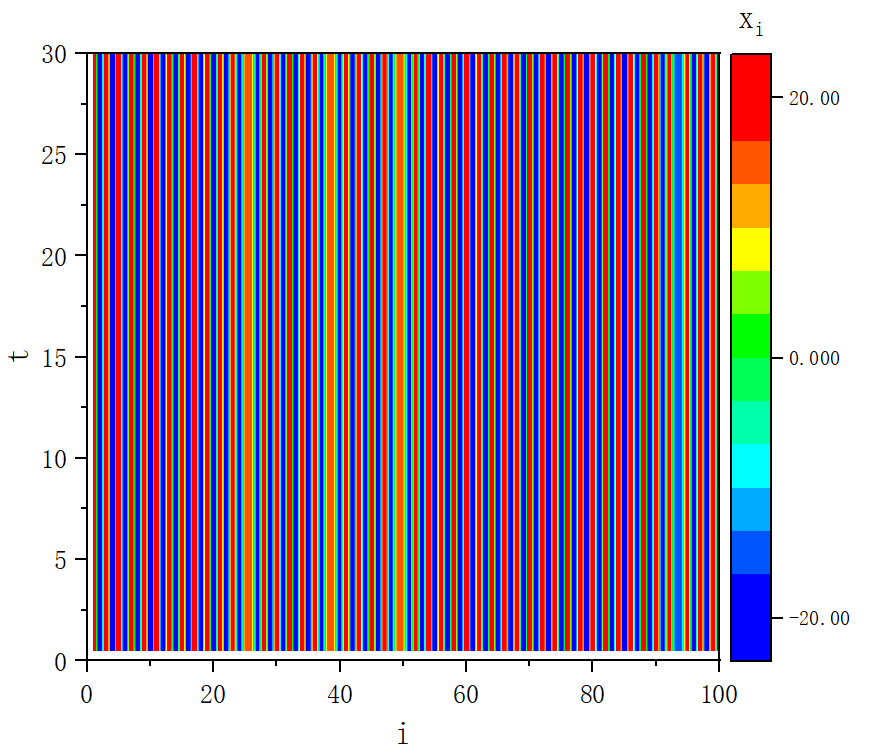
figure 3_E

figure 3_F

figure 3_G

figure 3_H
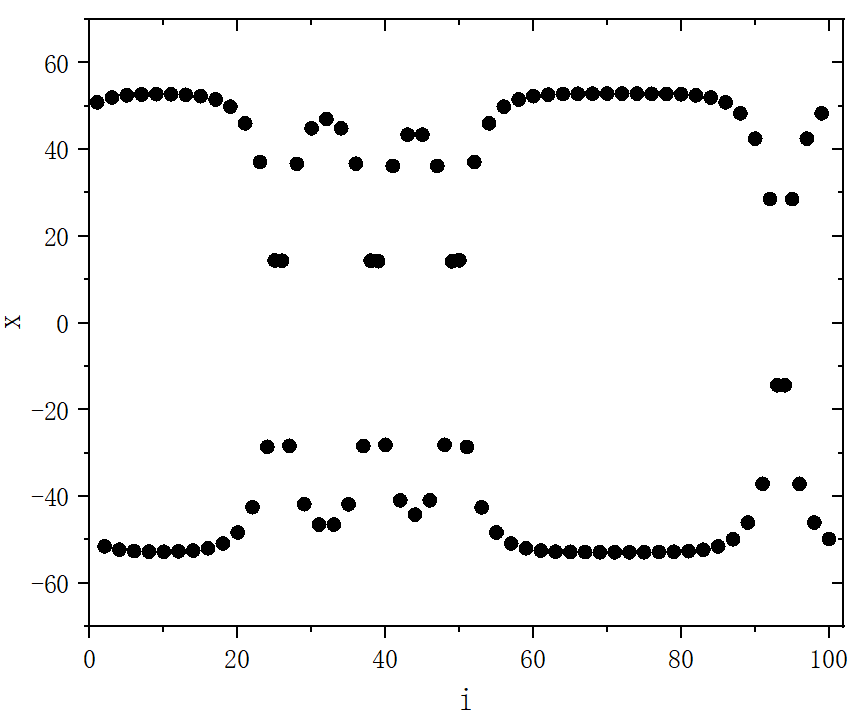
figure 3_I
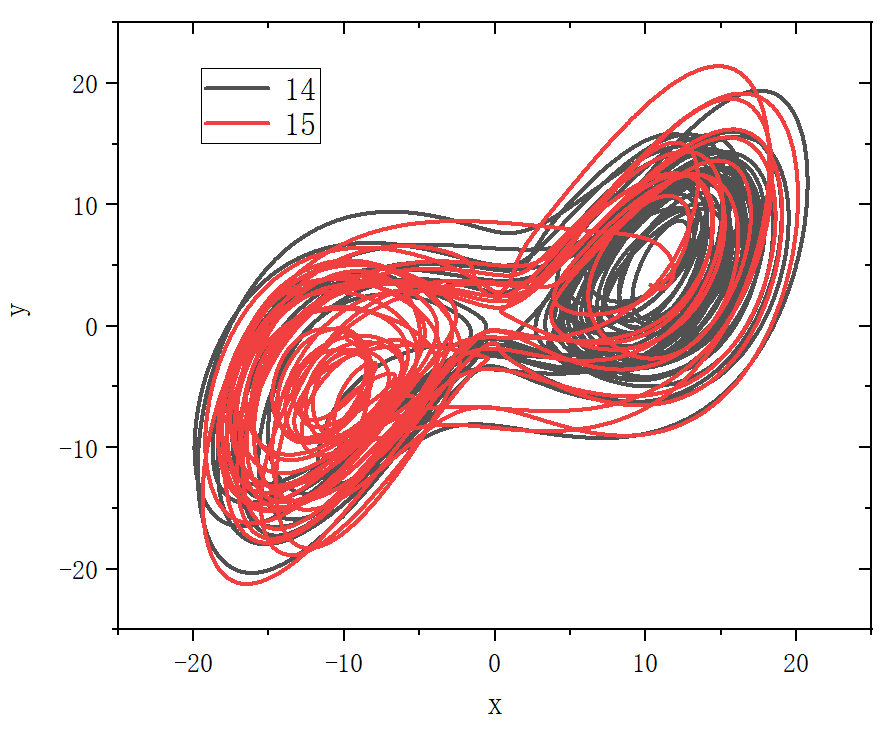
figure 3_J

figure 3_K
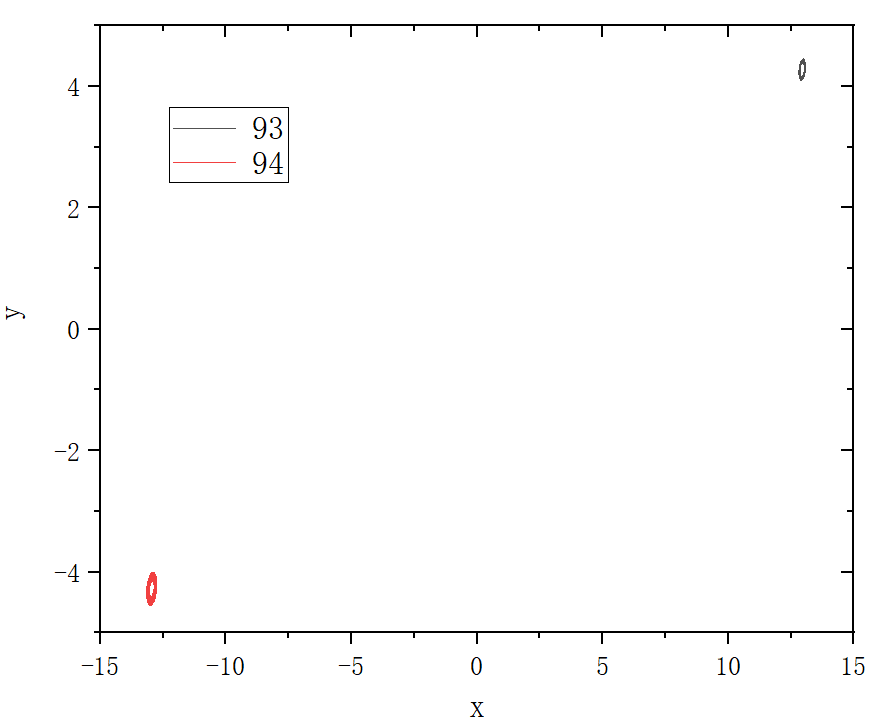
figure 3_L
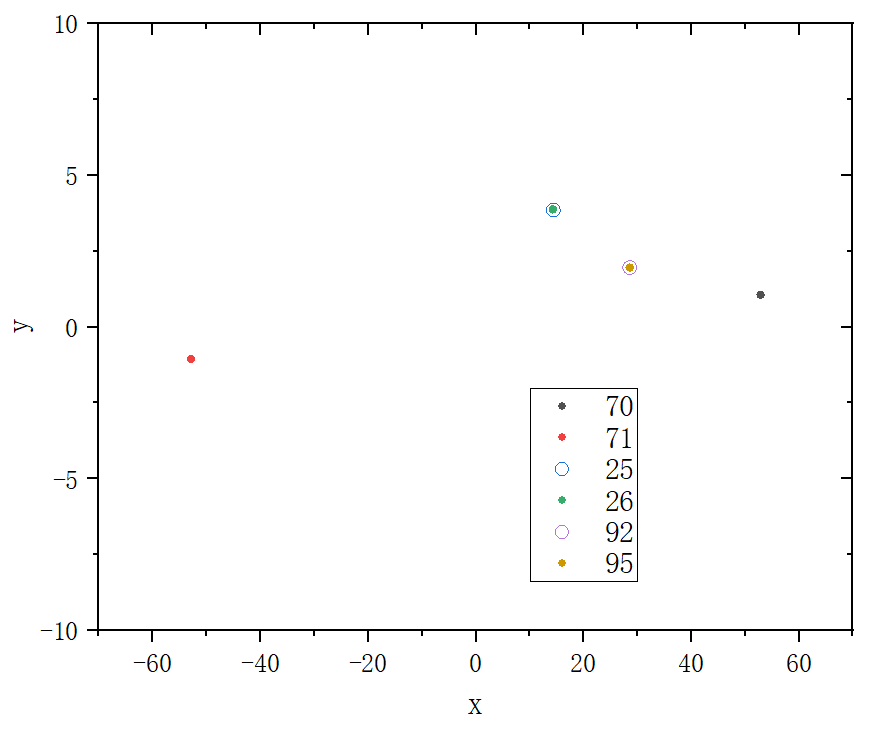
figure 4
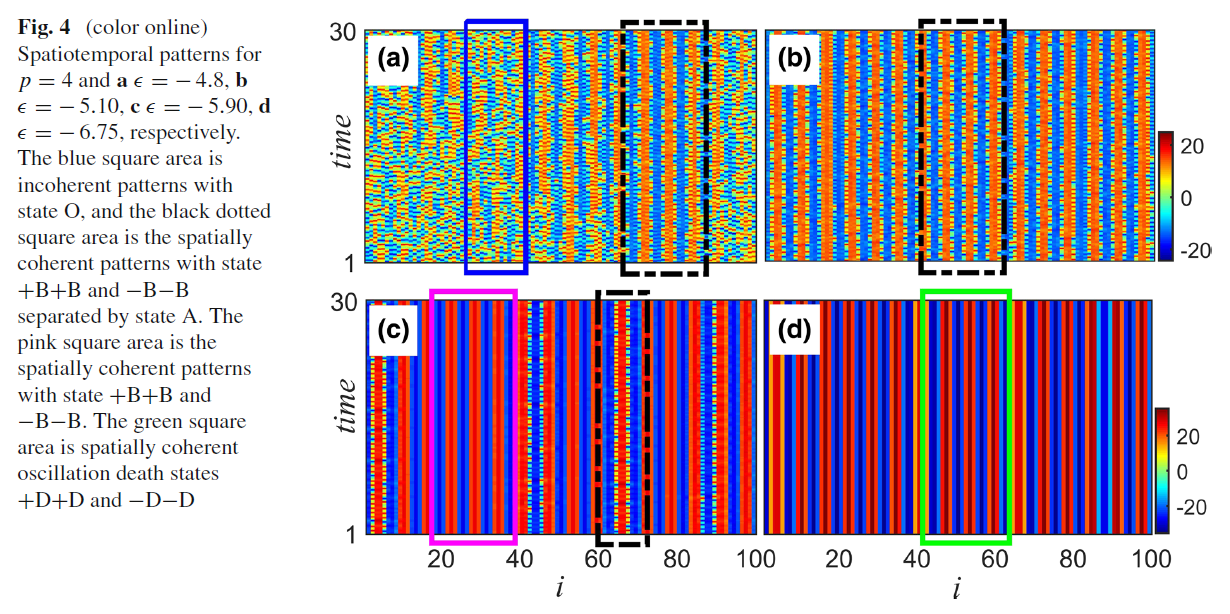
module Lorenz
implicit none
real,parameter :: h=0.001
integer,parameter :: MaxT=2030000,T_trans=2000000,N=3,M=100
real(kind=8) :: x(M,N)
integer :: p=4
integer,allocatable :: neighbour_matrix(:,:)
contains
subroutine x0()
implicit none
integer :: i
real :: x1,x2,x3
call random_seed()
do i=1,M,1
call random_number(x1)
call random_number(x2)
call random_number(x3)
x(i,1)=31.0*x1-14.0
x(i,2)=44.0*x2-20.0
x(i,3)=23.0*x3-1.0
write(20,*) x(i,1),x(i,2),x(i,3)
end do
end subroutine x0
subroutine fnf(xx,fx,i)
implicit none
real(kind=8) :: xx(N),fx(N)
integer :: t,j,i
real(kind=8) :: a,b,c,coupling,epsilon
coupling=0.0
epsilon=-5.90
do j=1,M,1
coupling=coupling+neighbour_matrix(i,j)*(x(j,1)-x(i,1))
end do
a=10.0
b=2.0
c=28.0
fx(1)=a*(xx(2)-xx(1))+(epsilon/real(2.0*p))*coupling
fx(2)=c*xx(1)-xx(1)*xx(3)-xx(2)
fx(3)=xx(1)*xx(2)-b*xx(3)
return
end subroutine fnf
subroutine rk4(x,t)
implicit none
integer :: i,j,t
real(kind=8) :: x(M,N),xx(N),fx(N)
real(kind=8) :: kx1(N),kx2(N),kx3(N),kx4(N)
do i=1,M,1
xx=x(i,:)
call fnf(xx,fx,i)
kx1=h*fx
xx=x(i,:)+0.5*kx1
call fnf(xx,fx,i)
kx2=h*fx
xx=x(i,:)+0.5*kx2
call fnf(xx,fx,i)
kx3=h*fx
xx=x(i,:)+kx3
call fnf(xx,fx,i)
kx4=h*fx
x(i,:)=x(i,:)+(kx1+2.0*kx2+2.0*kx3+kx4)/6.0
end do
return
end subroutine rk4
!max与min
subroutine Max_Min(xxx,max,min)
implicit none
real(kind=8) :: max(M),min(M),xxx(M)
integer :: i
do i=1,M,1
if(max(i)<xxx(i)) then
max(i)=xxx(i)
end if
if(min(i)>xxx(i)) then
min(i)=xxx(i)
end if
end do
return
end subroutine Max_Min
!建立网络矩阵
subroutine neighbour(K)
implicit none
integer :: K !单节点K个邻居
integer :: i,j,number
allocate(neighbour_matrix(M,M))
!初始化网络矩阵
neighbour_matrix=0
do i=1,M-1,1
do j=i+1,M,1
if(abs(i-j)<=K/2.or.abs(i-j)>=M-K/2) then
neighbour_matrix(i,j)=1
neighbour_matrix(j,i)=1
end if
end do
end do
!输出矩阵
do i=1,M,1
do j=1,M,1
write(10,"(I2)",advance='no') neighbour_matrix(i,j)
end do
write(10,*)
end do
return
end subroutine neighbour
end module Lorenz
program main
use Lorenz
implicit none
integer :: i,j,t
real(kind=8) :: max(M),min(M)
open(10,file="neighbour_matrix.txt")
open(20,file="x0.txt")
open(30,file="c_M_max_min.txt")
open(40,file="t_x_y_z_14.txt")
open(50,file="t_x_y_z_15.txt")
open(60,file="i_t_x_y_z.txt")
open(70,file="i_t_x_y_z_kuaizhao.txt")
open(80,file="i_t_x_y_z_all.txt")
max=-10000.0
min=10000.0
call x0()
call neighbour(2*p)
do t=1,MaxT,1
call rk4(x,t)
if(t>T_trans) then
call Max_Min(x(:,1),max,min)
write(40,"(4(F15.6))") (t-T_trans)*h,x(14,1),x(14,2),x(14,3)
write(50,"(4(F15.6))") (t-T_trans)*h,x(15,1),x(15,2),x(15,3)
do i=1,M,1
write(80,"(5(F15.6))") real(i),(t-T_trans)*h,x(i,1),x(i,2),x(i,3)
if((t-T_trans)*h==20) then
write(70,"(5(F15.6))") real(i),(t-T_trans)*h,x(i,1),x(i,2),x(i,3)
end if
if(mod(t,50)==0) then
write(60,"(5(F15.6))") real(i),(t-T_trans)*h,x(i,1),x(i,2),x(i,3)
end if
end do
end if
end do
do j=1,M,1
write(30,*) j,max(j),min(j)
end do
end program mainfigure 4_A

figure 4_B

figure 4_C
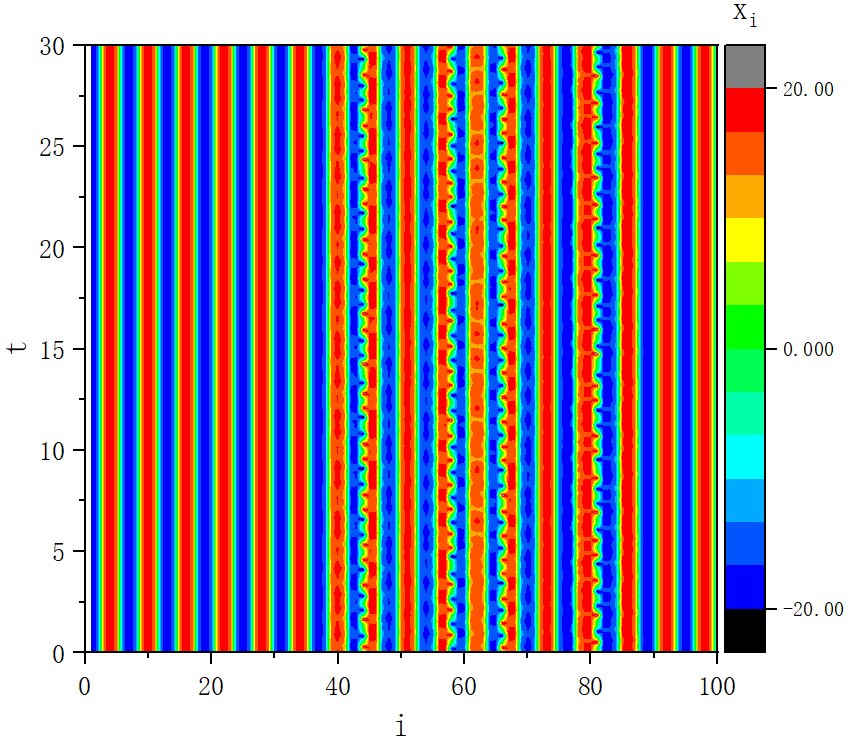
figure 4_D

figure 5
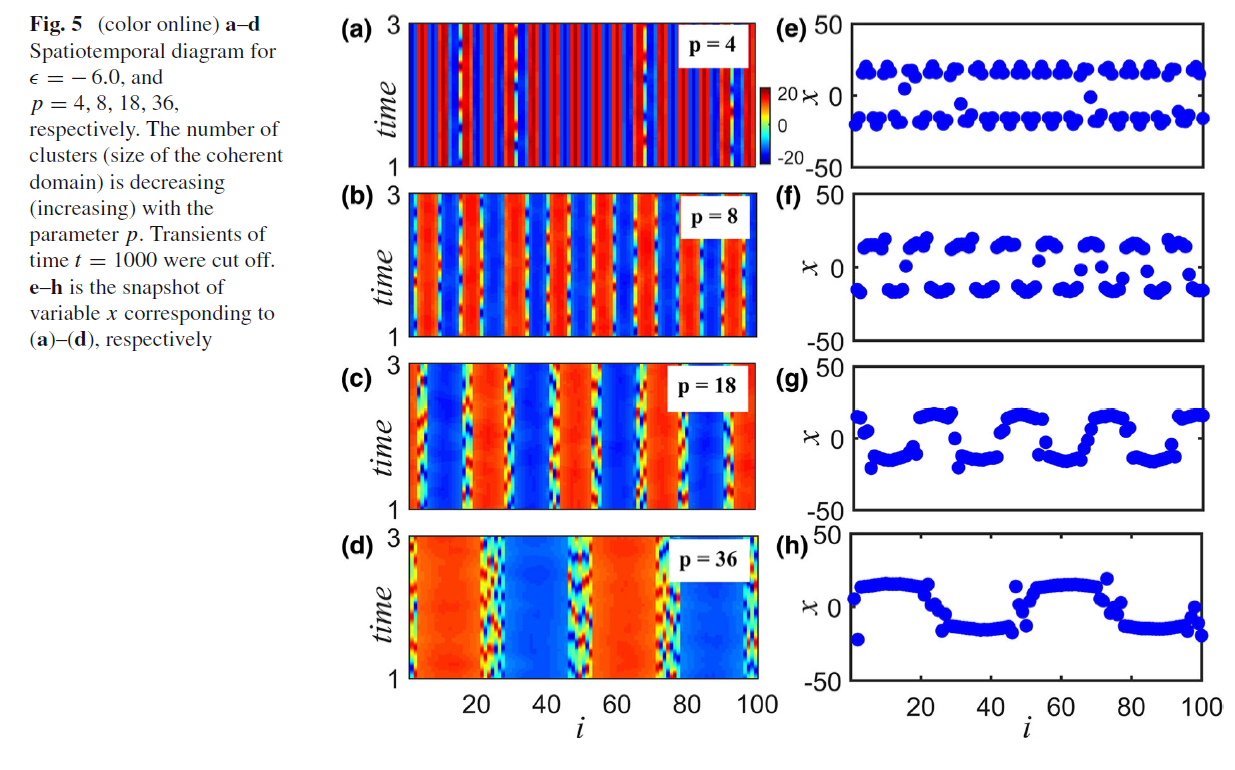
module Lorenz
implicit none
real,parameter :: h=0.001
integer,parameter :: MaxT=1003000,T_trans=1000000,N=3,M=100
real(kind=8) :: x(M,N)
integer :: p=36
integer,allocatable :: neighbour_matrix(:,:)
contains
subroutine x0()
implicit none
integer :: i
real :: x1,x2,x3
call random_seed()
do i=1,M,1
call random_number(x1)
call random_number(x2)
call random_number(x3)
x(i,1)=31.0*x1-14.0
x(i,2)=44.0*x2-20.0
x(i,3)=23.0*x3-1.0
write(20,*) x(i,1),x(i,2),x(i,3)
end do
end subroutine x0
subroutine fnf(xx,fx,i)
implicit none
real(kind=8) :: xx(N),fx(N)
integer :: t,j,i
real(kind=8) :: a,b,c,coupling,epsilon
coupling=0.0
epsilon=-6.0
do j=1,M,1
coupling=coupling+neighbour_matrix(i,j)*(x(j,1)-x(i,1))
end do
a=10.0
b=2.0
c=28.0
fx(1)=a*(xx(2)-xx(1))+(epsilon/real(2.0*p))*coupling
fx(2)=c*xx(1)-xx(1)*xx(3)-xx(2)
fx(3)=xx(1)*xx(2)-b*xx(3)
return
end subroutine fnf
subroutine rk4(x,t)
implicit none
integer :: i,j,t
real(kind=8) :: x(M,N),xx(N),fx(N)
real(kind=8) :: kx1(N),kx2(N),kx3(N),kx4(N)
do i=1,M,1
xx=x(i,:)
call fnf(xx,fx,i)
kx1=h*fx
xx=x(i,:)+0.5*kx1
call fnf(xx,fx,i)
kx2=h*fx
xx=x(i,:)+0.5*kx2
call fnf(xx,fx,i)
kx3=h*fx
xx=x(i,:)+kx3
call fnf(xx,fx,i)
kx4=h*fx
x(i,:)=x(i,:)+(kx1+2.0*kx2+2.0*kx3+kx4)/6.0
end do
return
end subroutine rk4
!max与min
subroutine Max_Min(xxx,max,min)
implicit none
real(kind=8) :: max(M),min(M),xxx(M)
integer :: i
do i=1,M,1
if(max(i)<xxx(i)) then
max(i)=xxx(i)
end if
if(min(i)>xxx(i)) then
min(i)=xxx(i)
end if
end do
return
end subroutine Max_Min
!建立网络矩阵
subroutine neighbour(K)
implicit none
integer :: K !单节点K个邻居
integer :: i,j,number
allocate(neighbour_matrix(M,M))
!初始化网络矩阵
neighbour_matrix=0
do i=1,M-1,1
do j=i+1,M,1
if(abs(i-j)<=K/2.or.abs(i-j)>=M-K/2) then
neighbour_matrix(i,j)=1
neighbour_matrix(j,i)=1
end if
end do
end do
!输出矩阵
do i=1,M,1
do j=1,M,1
write(10,"(I2)",advance='no') neighbour_matrix(i,j)
end do
write(10,*)
end do
return
end subroutine neighbour
end module Lorenz
program main
use Lorenz
implicit none
integer :: i,j,t
real(kind=8) :: max(M),min(M)
open(10,file="neighbour_matrix.txt")
open(20,file="x0.txt")
open(30,file="c_M_max_min.txt")
open(40,file="t_x_y_z_14.txt")
open(50,file="t_x_y_z_15.txt")
open(60,file="i_t_x_y_z.txt")
open(70,file="i_t_x_y_z_kuaizhao.txt")
open(80,file="i_t_x_y_z_all.txt")
max=-10000.0
min=10000.0
call x0()
call neighbour(2*p)
do t=1,MaxT,1
call rk4(x,t)
if(t>T_trans) then
call Max_Min(x(:,1),max,min)
write(40,"(4(F15.6))") (t-T_trans)*h,x(14,1),x(14,2),x(14,3)
write(50,"(4(F15.6))") (t-T_trans)*h,x(15,1),x(15,2),x(15,3)
do i=1,M,1
write(80,"(5(F15.6))") real(i),(t-T_trans)*h,x(i,1),x(i,2),x(i,3)
if(t-1==T_trans) then
write(70,"(5(F15.6))") real(i),(t-T_trans)*h,x(i,1),x(i,2),x(i,3)
end if
if(mod(t,10)==0) then
write(60,"(5(F15.6))") real(i),(t-T_trans)*h,x(i,1),x(i,2),x(i,3)
end if
end do
end if
end do
do j=1,M,1
write(30,*) j,max(j),min(j)
end do
end program mainfigure 5_A
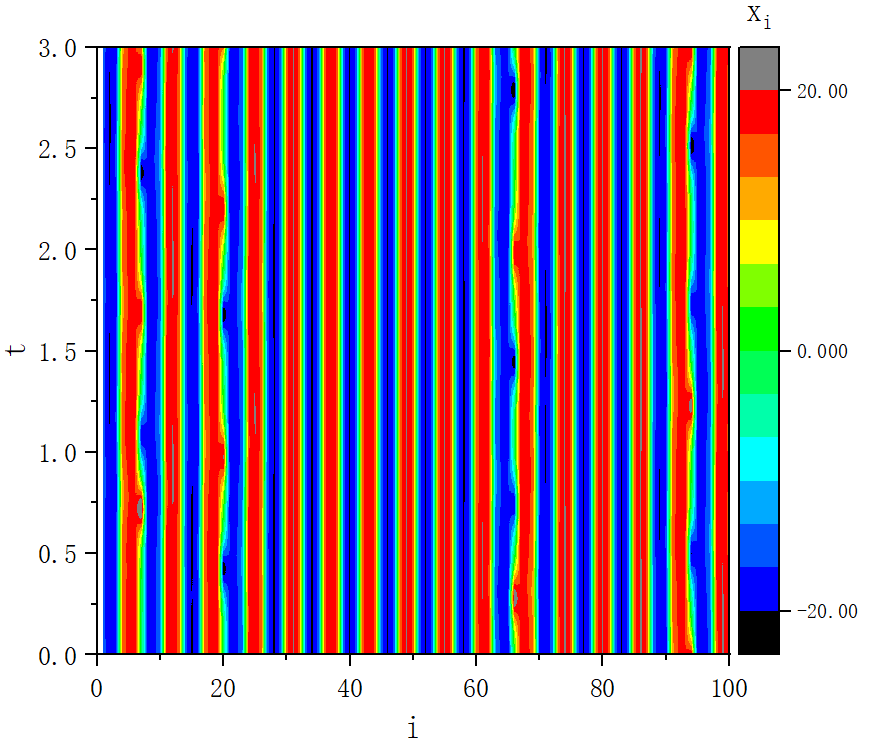
figure 5_B

figure 5_C
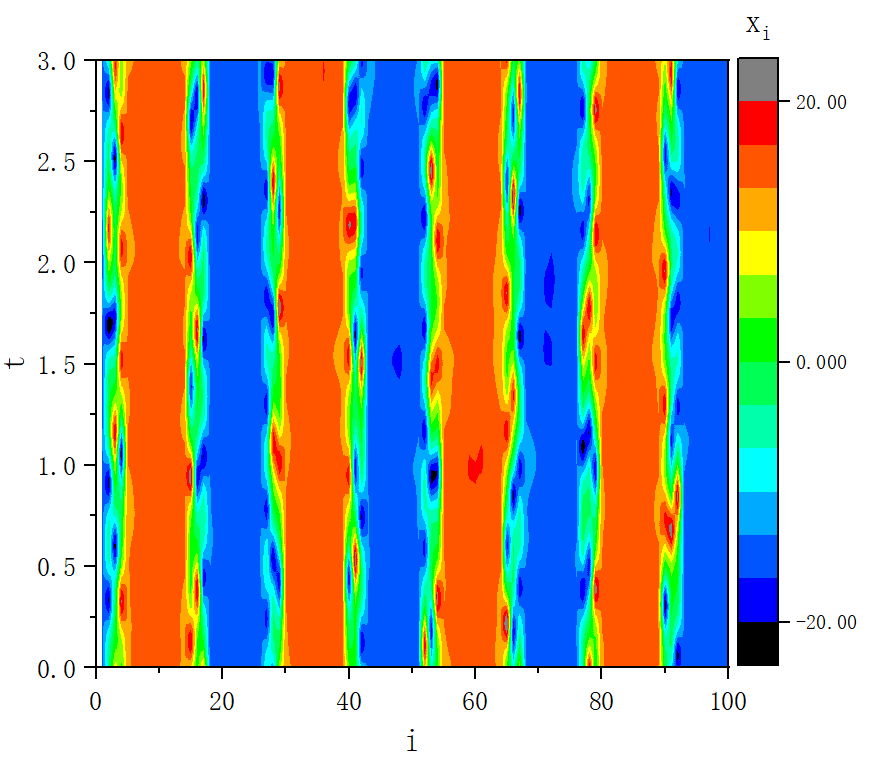
figure 5_D

figure 5_E

figure 5_F
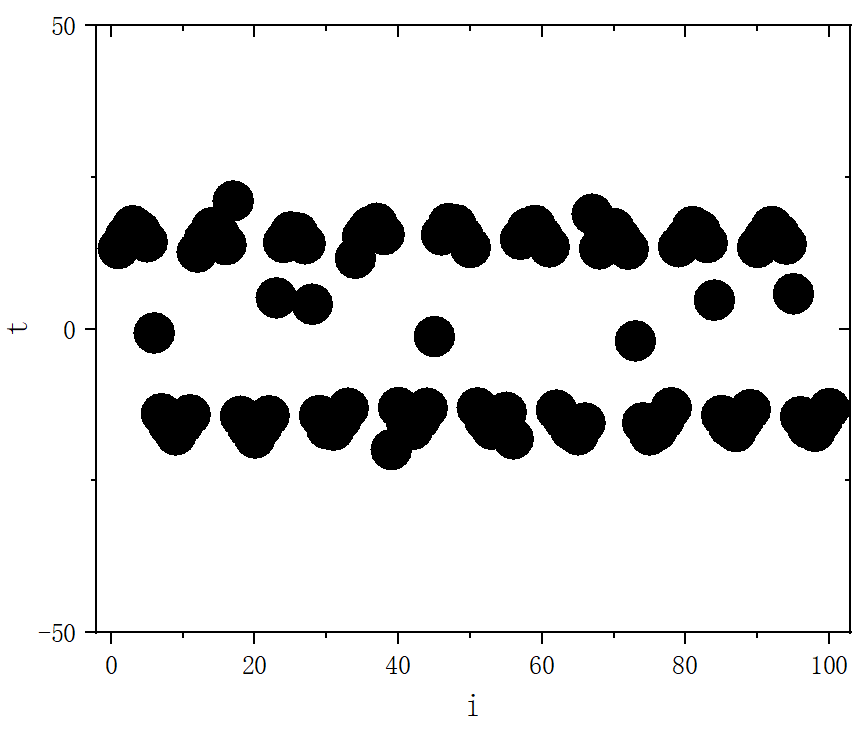
figure 5_G
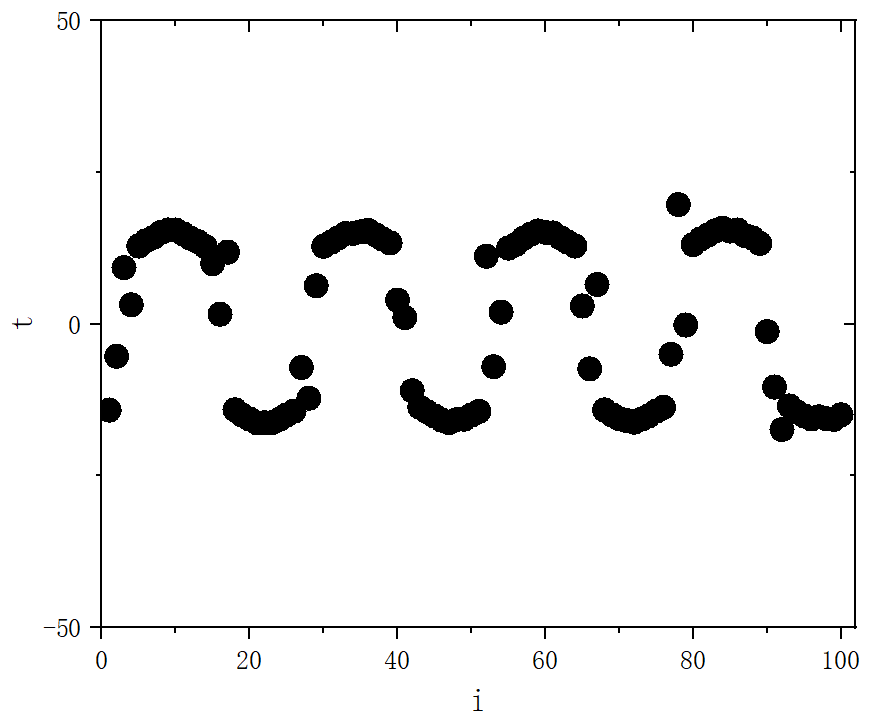
figure 5_H

figure 6
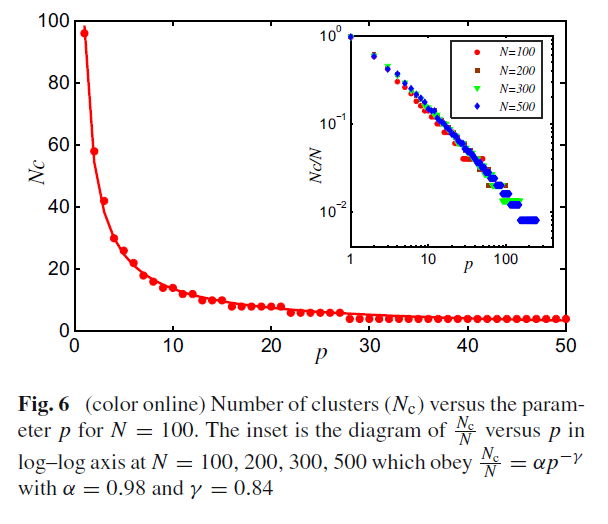
module Lorenz
implicit none
real,parameter :: h=0.001
integer,parameter :: MaxT=1030000,T_trans=1000000,N=3,M=200
real(kind=8) :: x(M,N)
integer :: p
integer,allocatable :: neighbour_matrix(:,:)
contains
subroutine x0()
implicit none
integer :: i
real :: x1,x2,x3
call random_seed()
do i=1,M,1
call random_number(x1)
call random_number(x2)
call random_number(x3)
x(i,1)=31.0*x1-14.0
x(i,2)=44.0*x2-20.0
x(i,3)=23.0*x3-1.0
!write(20,*) x(i,1),x(i,2),x(i,3)
end do
end subroutine x0
subroutine fnf(xx,fx,i)
implicit none
real(kind=8) :: xx(N),fx(N)
integer :: t,j,i
real(kind=8) :: a,b,c,coupling,epsilon
coupling=0.0
epsilon=-6.0
do j=1,M,1
coupling=coupling+neighbour_matrix(i,j)*(x(j,1)-x(i,1))
end do
a=10.0
b=2.0
c=28.0
fx(1)=a*(xx(2)-xx(1))+(epsilon/real(2.0*p))*coupling
fx(2)=c*xx(1)-xx(1)*xx(3)-xx(2)
fx(3)=xx(1)*xx(2)-b*xx(3)
return
end subroutine fnf
subroutine rk4(x,t)
implicit none
integer :: i,j,t
real(kind=8) :: x(M,N),xx(N),fx(N)
real(kind=8) :: kx1(N),kx2(N),kx3(N),kx4(N)
do i=1,M,1
xx=x(i,:)
call fnf(xx,fx,i)
kx1=h*fx
xx=x(i,:)+0.5*kx1
call fnf(xx,fx,i)
kx2=h*fx
xx=x(i,:)+0.5*kx2
call fnf(xx,fx,i)
kx3=h*fx
xx=x(i,:)+kx3
call fnf(xx,fx,i)
kx4=h*fx
x(i,:)=x(i,:)+(kx1+2.0*kx2+2.0*kx3+kx4)/6.0
end do
return
end subroutine rk4
!max与min
subroutine Max_Min(xxx,max,min)
implicit none
real(kind=8) :: max(M),min(M),xxx(M)
integer :: i
do i=1,M,1
if(max(i)<xxx(i)) then
max(i)=xxx(i)
end if
if(min(i)>xxx(i)) then
min(i)=xxx(i)
end if
end do
return
end subroutine Max_Min
!建立网络矩阵
subroutine neighbour(K)
implicit none
integer :: K !单节点K个邻居
integer :: i,j,number
allocate(neighbour_matrix(M,M))
!初始化网络矩阵
neighbour_matrix=0
do i=1,M-1,1
do j=i+1,M,1
if(abs(i-j)<=K/2.or.abs(i-j)>=M-K/2) then
neighbour_matrix(i,j)=1
neighbour_matrix(j,i)=1
end if
end do
end do
!输出矩阵
! do i=1,M,1
! do j=1,M,1
! write(10,"(I2)",advance='no') neighbour_matrix(i,j)
! end do
! write(10,*)
! end do
return
end subroutine neighbour
end module Lorenz
program main
use Lorenz
implicit none
integer :: i,j,t,Nc
real(kind=8) :: max(M),min(M)
open(10,file="neighbour_matrix.txt")
open(20,file="x0.txt")
open(30,file="c_M_max_min.txt")
open(40,file="t_x_y_z_14.txt")
open(50,file="t_x_y_z_15.txt")
open(60,file="i_t_x_y_z.txt")
open(70,file="i_t_x_y_z_kuaizhao.txt")
open(80,file="i_t_x_y_z_all.txt")
open(90,file="p_Nc.txt")
do p=1,50,1
max=-10000.0
min=10000.0
Nc=0
call x0()
call neighbour(2*p)
do t=1,MaxT,1
call rk4(x,t)
if(t>T_trans) then
call Max_Min(x(:,1),max,min)
! write(40,"(4(F15.6))") (t-T_trans)*h,x(14,1),x(14,2),x(14,3)
! write(50,"(4(F15.6))") (t-T_trans)*h,x(15,1),x(15,2),x(15,3)
do i=1,M,1
!write(80,"(5(F15.6))") real(i),(t-T_trans)*h,x(i,1),x(i,2),x(i,3)
!if((t-T_trans)*h==20) then
! write(70,"(5(F15.6))") real(i),(t-T_trans)*h,x(i,1),x(i,2),x(i,3)
!end if
!if(mod(t,50)==0) then
! write(60,"(5(F15.6))") real(i),(t-T_trans)*h,x(i,1),x(i,2),x(i,3)
!end if
end do
end if
end do
do j=1,M-1,1
write(30,*) j,max(j),min(j)
if(((max(j)>0.and.min(j)>0).and.max(j+1)<0).or.((max(j)<0.and.min(j)<0).and.max(j+1)>0)) then
Nc=Nc+1
end if
end do
write(90,*) p,Nc
write(*,*) p,Nc
deallocate(neighbour_matrix)
end do
end program mainfigure 6_A

figure 7

module Lorenz
implicit none
real,parameter :: h=0.001
integer,parameter :: MaxT=2030000,T_trans=2000000,N=3,M=100
real(kind=8) :: x(M,N)
integer :: p
integer,allocatable :: neighbour_matrix(:,:)
contains
subroutine x0()
implicit none
integer :: i
real :: x1,x2,x3
call random_seed()
do i=1,M,1
call random_number(x1)
call random_number(x2)
call random_number(x3)
x(i,1)=31.0*x1-14.0
x(i,2)=44.0*x2-20.0
x(i,3)=23.0*x3-1.0
write(20,*) x(i,1),x(i,2),x(i,3)
end do
end subroutine x0
subroutine fnf(xx,fx,i)
implicit none
real(kind=8) :: xx(N),fx(N)
integer :: t,j,i
real(kind=8) :: a,b,c,coupling,epsilon
coupling=0.0
epsilon=-7.5
do j=1,M,1
coupling=coupling+neighbour_matrix(i,j)*(x(j,1)-x(i,1))
end do
a=10.0
b=2.0
c=28.0
fx(1)=a*(xx(2)-xx(1))+(epsilon/real(2.0*p))*coupling
fx(2)=c*xx(1)-xx(1)*xx(3)-xx(2)
fx(3)=xx(1)*xx(2)-b*xx(3)
return
end subroutine fnf
subroutine rk4(x,t)
implicit none
integer :: i,j,t
real(kind=8) :: x(M,N),xx(N),fx(N)
real(kind=8) :: kx1(N),kx2(N),kx3(N),kx4(N)
do i=1,M,1
xx=x(i,:)
call fnf(xx,fx,i)
kx1=h*fx
xx=x(i,:)+0.5*kx1
call fnf(xx,fx,i)
kx2=h*fx
xx=x(i,:)+0.5*kx2
call fnf(xx,fx,i)
kx3=h*fx
xx=x(i,:)+kx3
call fnf(xx,fx,i)
kx4=h*fx
x(i,:)=x(i,:)+(kx1+2.0*kx2+2.0*kx3+kx4)/6.0
end do
return
end subroutine rk4
!max与min
subroutine Max_Min(xxx,max,min)
implicit none
real(kind=8) :: max(M),min(M),xxx(M)
integer :: i
do i=1,M,1
if(max(i)<xxx(i)) then
max(i)=xxx(i)
end if
if(min(i)>xxx(i)) then
min(i)=xxx(i)
end if
end do
return
end subroutine Max_Min
!建立网络矩阵
subroutine neighbour(K)
implicit none
integer :: K !单节点K个邻居
integer :: i,j,number
allocate(neighbour_matrix(M,M))
!初始化网络矩阵
neighbour_matrix=0
do i=1,M-1,1
do j=i+1,M,1
if(abs(i-j)<=K/2.or.abs(i-j)>=M-K/2) then
neighbour_matrix(i,j)=1
neighbour_matrix(j,i)=1
end if
end do
end do
!输出矩阵
! do i=1,M,1
! do j=1,M,1
! write(10,"(I2)",advance='no') neighbour_matrix(i,j)
! end do
! write(10,*)
! end do
return
end subroutine neighbour
end module Lorenz
program main
use Lorenz
implicit none
integer :: i,j,t,Nc
real(kind=8) :: max(M),min(M)
open(10,file="neighbour_matrix.txt")
open(20,file="x0.txt")
open(30,file="c_M_max_min.txt")
open(40,file="t_x_y_z_14.txt")
open(50,file="t_x_y_z_15.txt")
open(60,file="i_t_x_y_z.txt")
open(70,file="i_t_x_y_z_kuaizhao.txt")
open(80,file="i_t_x_y_z_all.txt")
open(90,file="p_Nc.txt")
do p=10,10,1
max=-10000.0
min=10000.0
Nc=0
call x0()
call neighbour(2*p)
do t=1,MaxT,1
call rk4(x,t)
if(t>T_trans) then
call Max_Min(x(:,1),max,min)
! write(40,"(4(F15.6))") (t-T_trans)*h,x(14,1),x(14,2),x(14,3)
! write(50,"(4(F15.6))") (t-T_trans)*h,x(15,1),x(15,2),x(15,3)
do i=1,M,1
write(80,"(5(F15.6))") real(i),(t-T_trans)*h,x(i,1),x(i,2),x(i,3)
if(t-1==T_trans) then
write(70,"(5(F15.6))") real(i),(t-T_trans)*h,x(i,1),x(i,2),x(i,3)
end if
if(mod(t,50)==0) then
write(60,"(5(F15.6))") real(i),(t-T_trans)*h,x(i,1),x(i,2),x(i,3)
end if
end do
end if
end do
do j=1,M,1
write(30,*) j,max(j),min(j)
if((max(j)>0.and.min(j)>0).or.(max(j)<0.and.min(j)<0)) then
Nc=Nc+1
end if
end do
write(90,*) p,Nc
write(*,*) p,Nc
deallocate(neighbour_matrix)
end do
end program mainfigure 7_A
module Lorenz
implicit none
real,parameter :: h=0.001
integer,parameter :: MaxT=2030000,T_trans=2000000,N=3,M=100
real(kind=8) :: x(M,N)
integer :: p
integer,allocatable :: neighbour_matrix(:,:)
contains
subroutine x0()
implicit none
integer :: i
real :: x1,x2,x3
call random_seed()
do i=1,M,1
call random_number(x1)
call random_number(x2)
call random_number(x3)
x(i,1)=31.0*x1-14.0
x(i,2)=44.0*x2-20.0
x(i,3)=23.0*x3-1.0
write(20,*) x(i,1),x(i,2),x(i,3)
end do
end subroutine x0
subroutine fnf(xx,fx,i)
implicit none
real(kind=8) :: xx(N),fx(N)
integer :: t,j,i
real(kind=8) :: a,b,c,coupling,epsilon
coupling=0.0
epsilon=-7.5
do j=1,M,1
coupling=coupling+neighbour_matrix(i,j)*(x(j,1)-x(i,1))
end do
a=10.0
b=2.0
c=28.0
fx(1)=a*(xx(2)-xx(1))+(epsilon/real(2.0*p))*coupling
fx(2)=c*xx(1)-xx(1)*xx(3)-xx(2)
fx(3)=xx(1)*xx(2)-b*xx(3)
return
end subroutine fnf
subroutine rk4(x,t)
implicit none
integer :: i,j,t
real(kind=8) :: x(M,N),xx(N),fx(N)
real(kind=8) :: kx1(N),kx2(N),kx3(N),kx4(N)
do i=1,M,1
xx=x(i,:)
call fnf(xx,fx,i)
kx1=h*fx
xx=x(i,:)+0.5*kx1
call fnf(xx,fx,i)
kx2=h*fx
xx=x(i,:)+0.5*kx2
call fnf(xx,fx,i)
kx3=h*fx
xx=x(i,:)+kx3
call fnf(xx,fx,i)
kx4=h*fx
x(i,:)=x(i,:)+(kx1+2.0*kx2+2.0*kx3+kx4)/6.0
end do
return
end subroutine rk4
!max与min
subroutine Max_Min(xxx,max,min)
implicit none
real(kind=8) :: max(M),min(M),xxx(M)
integer :: i
do i=1,M,1
if(max(i)<xxx(i)) then
max(i)=xxx(i)
end if
if(min(i)>xxx(i)) then
min(i)=xxx(i)
end if
end do
return
end subroutine Max_Min
!建立网络矩阵
subroutine neighbour(K)
implicit none
integer :: K !单节点K个邻居
integer :: i,j,number
allocate(neighbour_matrix(M,M))
!初始化网络矩阵
neighbour_matrix=0
do i=1,M-1,1
do j=i+1,M,1
if(abs(i-j)<=K/2.or.abs(i-j)>=M-K/2) then
neighbour_matrix(i,j)=1
neighbour_matrix(j,i)=1
end if
end do
end do
!输出矩阵
! do i=1,M,1
! do j=1,M,1
! write(10,"(I2)",advance='no') neighbour_matrix(i,j)
! end do
! write(10,*)
! end do
return
end subroutine neighbour
end module Lorenz
program main
use Lorenz
implicit none
integer :: i,j,t,Nc,count
real(kind=8) :: max(M),min(M),data_x(M),delta_D(M)
real,allocatable :: delta_DD(:),delta_DDD(:),delta_X(:)
open(10,file="neighbour_matrix.txt")
open(20,file="x0.txt")
open(30,file="c_M_max_min.txt")
open(40,file="t_x_y_z_14.txt")
open(50,file="t_x_y_z_15.txt")
open(60,file="i_t_x_y_z.txt")
open(70,file="i_t_x_y_z_kuaizhao.txt")
open(80,file="i_t_x_y_z_all.txt")
open(90,file="p_Nc_deltaD_deltaX.txt")
do p=7,50,1
max=-10000.0
min=10000.0
data_x=0.0
delta_D=0.0
count=1
Nc=0
call x0()
call neighbour(2*p)
do t=1,MaxT,1
call rk4(x,t)
if(t>T_trans) then
call Max_Min(x(:,1),max,min)
do i=1,M,1
if((t-T_trans)*h==20) then
data_x(i)=x(i,1)
! write(70,"(5(F15.6))") real(i),(t-T_trans)*h,x(i,1),x(i,2),x(i,3)
end if
end do
end if
end do
do j=1,M-1,1
write(30,*) j,max(j),min(j)
if(((max(j)>0.and.min(j)>0).and.max(j+1)<0).or.((max(j)<0.and.min(j)<0).and.max(j+1)>0)) then
delta_D(j)=j
Nc=Nc+1
end if
end do
allocate(delta_DD(Nc))
allocate(delta_DDD(Nc))
allocate(delta_X(Nc))
delta_DD=0.0
delta_DDD=0.0
delta_X=0.0
do j=1,M,1
if(delta_D(j)>0.0) then
delta_DD(count)=delta_D(j)
count=count+1
end if
end do
do j=1,Nc-1,1
delta_DDD(j)=abs(delta_DD(j+1)-delta_DD(j))
delta_X(j)=abs(maxval(data_x(delta_DD(j)+1:delta_DD(j+1)))-minval(data_x(delta_DD(j)+1:delta_DD(j+1))))
end do
write(*,*) p,Nc,"delta_X",maxval(delta_X(:)),"delta_DDD",maxval(delta_DDD(:))
write(90,*) p,Nc,maxval(delta_X(:)),maxval(delta_DDD(:))
deallocate(neighbour_matrix)
deallocate(delta_DD)
deallocate(delta_DDD)
deallocate(delta_X)
end do
end program main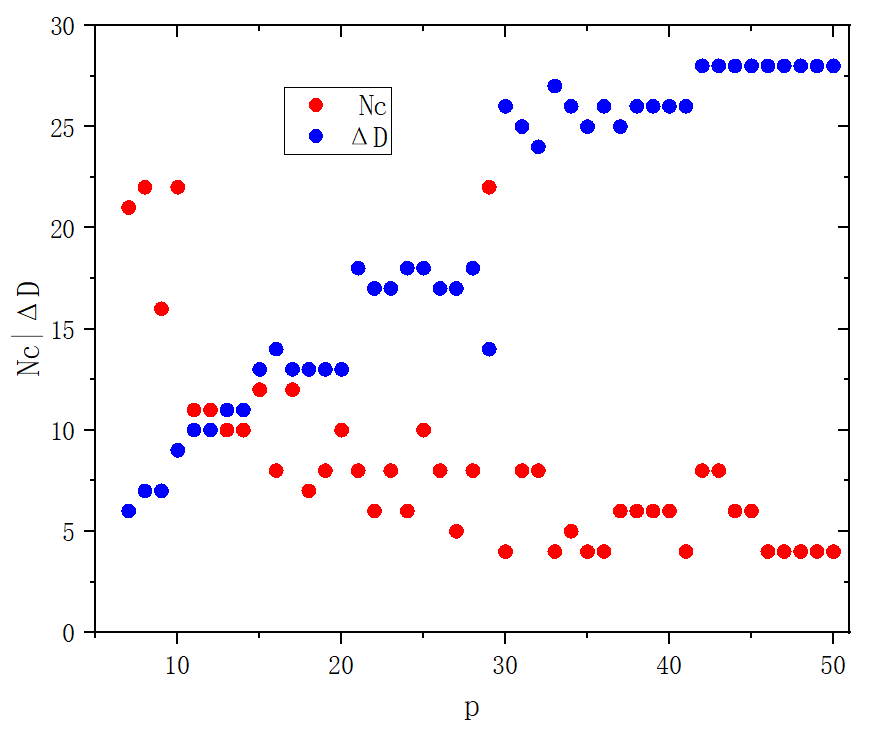
figure 7_B
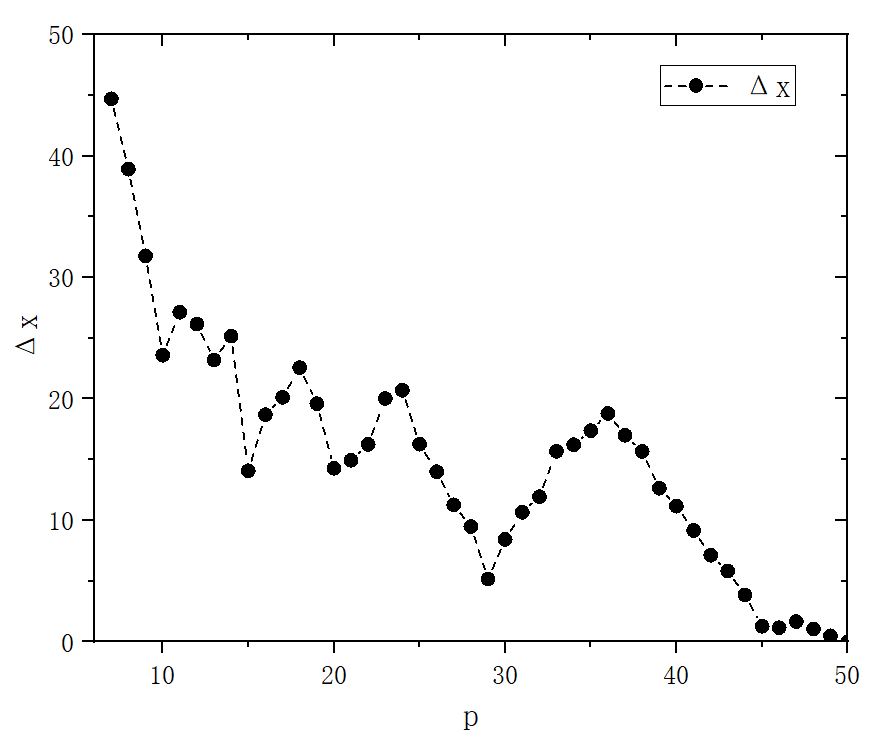
figure 7_C
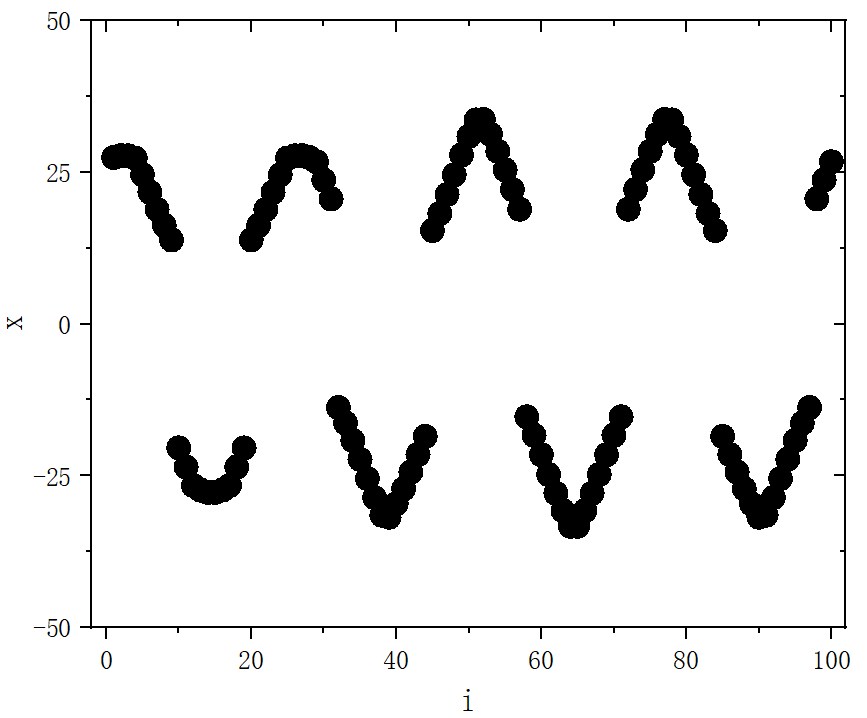
figure 7_D
- p=28

figure 7_E
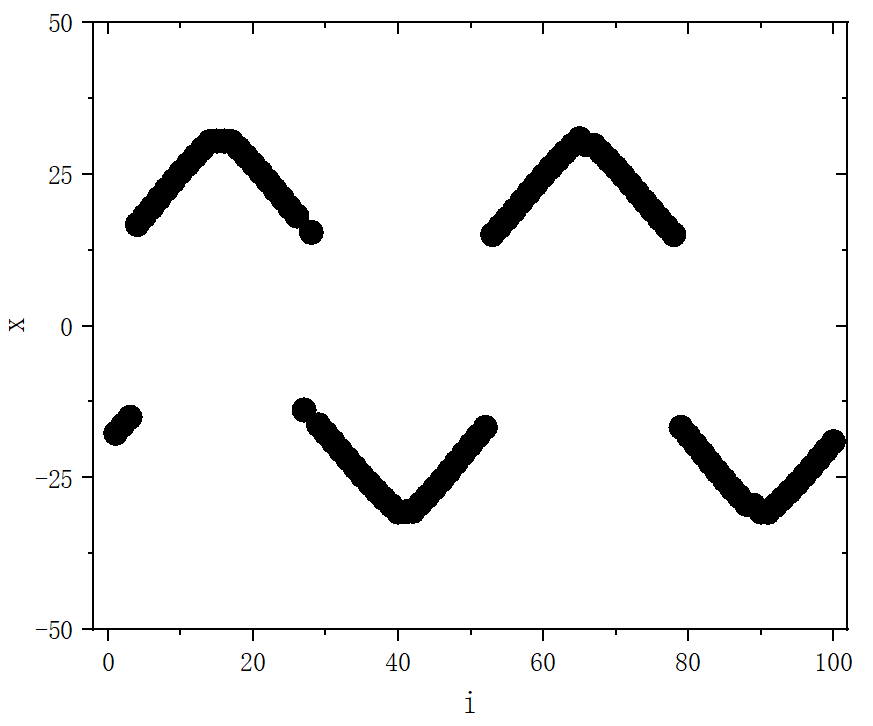
figure 7_F
- p=44
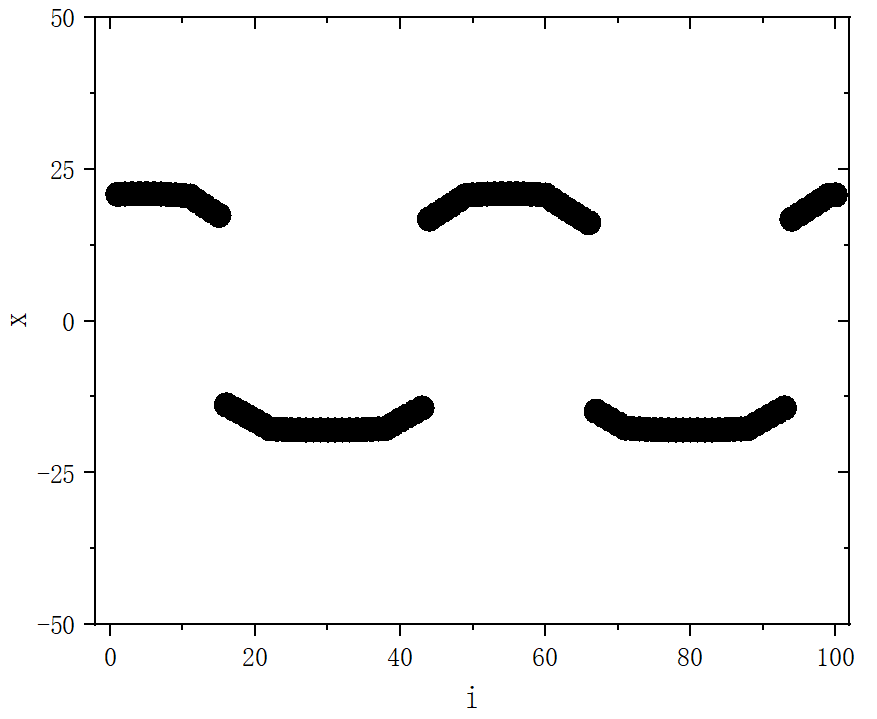
figure 8

figure 8_A
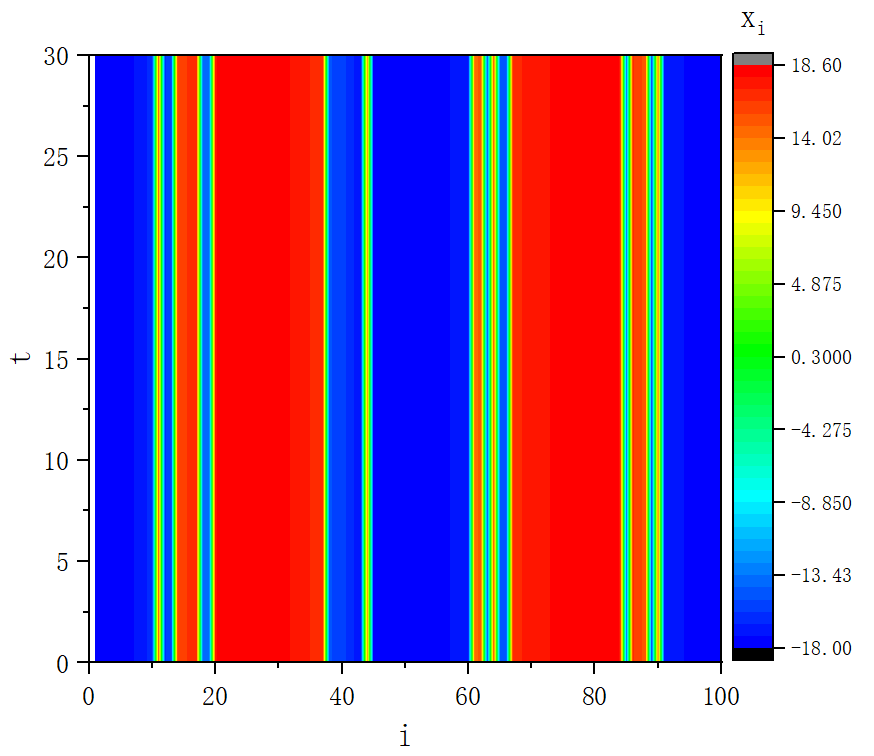
figure 8_B

figure 8_C

figure 8_D
p=28
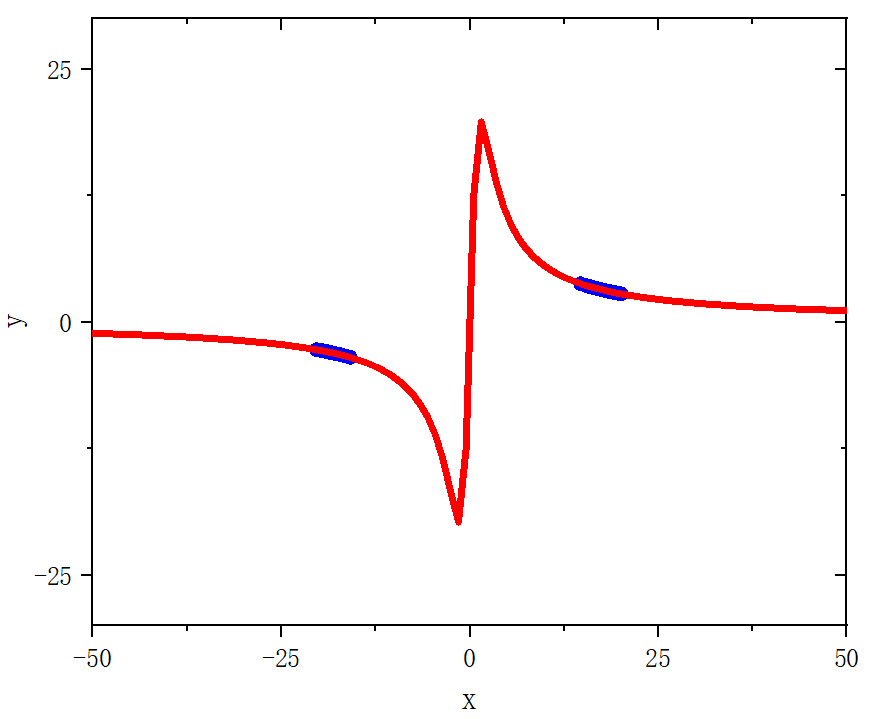
figure 8_E

figure 8_F
- p=44
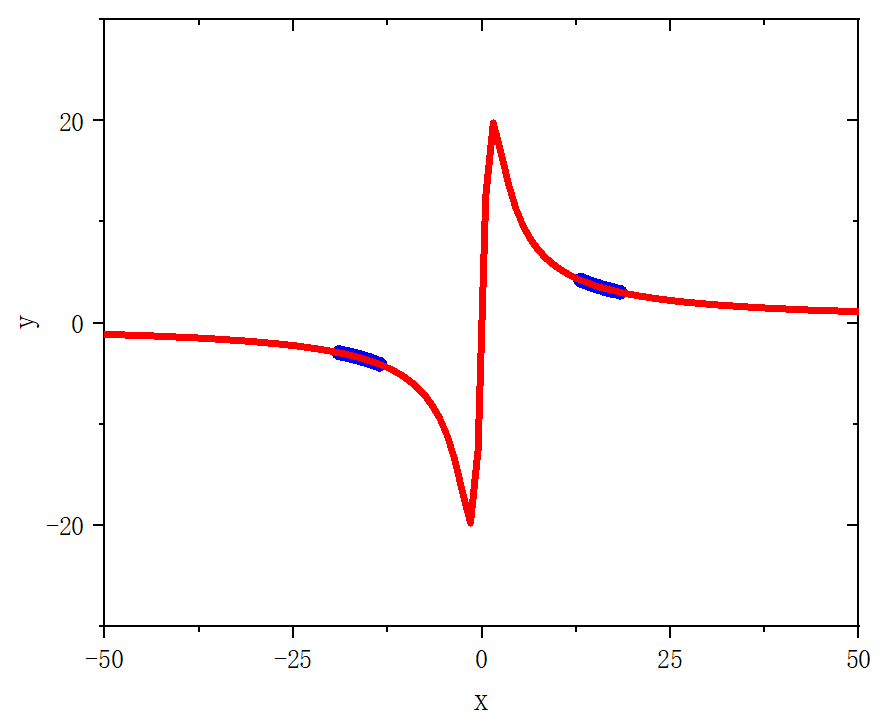
figure 9

- 时空斑图
module Lorenz
implicit none
real,parameter :: h=0.01
integer,parameter :: MaxT=200300,T_trans=200000,N=3,M=100
real(kind=8) :: x(M,N)
integer :: p=35
integer,allocatable :: neighbour_matrix(:,:)
contains
subroutine x0()
implicit none
integer :: i
real :: x1,x2,x3
call random_seed()
do i=1,M,1
call random_number(x1)
call random_number(x2)
call random_number(x3)
x(i,1)=31.0*x1-14.0
x(i,2)=44.0*x2-20.0
x(i,3)=23.0*x3-1.0
write(20,*) x(i,1),x(i,2),x(i,3)
end do
end subroutine x0
subroutine fnf(xx,fx,i)
implicit none
real(kind=8) :: xx(N),fx(N)
integer :: t,j,i
real(kind=8) :: a,b,c,coupling,epsilon
coupling=0.0
epsilon=-5.5
do j=1,M,1
coupling=coupling+neighbour_matrix(i,j)*(x(j,1)-x(i,1))
end do
a=10.0
b=2.0
c=28.0
fx(1)=a*(xx(2)-xx(1))+(epsilon/real(2.0*p))*coupling
fx(2)=c*xx(1)-xx(1)*xx(3)-xx(2)
fx(3)=xx(1)*xx(2)-b*xx(3)
return
end subroutine fnf
subroutine rk4(x,t)
implicit none
integer :: i,j,t
real(kind=8) :: x(M,N),xx(N),fx(N)
real(kind=8) :: kx1(N),kx2(N),kx3(N),kx4(N)
do i=1,M,1
xx=x(i,:)
call fnf(xx,fx,i)
kx1=h*fx
xx=x(i,:)+0.5*kx1
call fnf(xx,fx,i)
kx2=h*fx
xx=x(i,:)+0.5*kx2
call fnf(xx,fx,i)
kx3=h*fx
xx=x(i,:)+kx3
call fnf(xx,fx,i)
kx4=h*fx
x(i,:)=x(i,:)+(kx1+2.0*kx2+2.0*kx3+kx4)/6.0
end do
return
end subroutine rk4
!max与min
subroutine Max_Min(xxx,max,min)
implicit none
real(kind=8) :: max(M),min(M),xxx(M)
integer :: i
do i=1,M,1
if(max(i)<xxx(i)) then
max(i)=xxx(i)
end if
if(min(i)>xxx(i)) then
min(i)=xxx(i)
end if
end do
return
end subroutine Max_Min
!建立网络矩阵
subroutine neighbour(K)
implicit none
integer :: K !单节点K个邻居
integer :: i,j,number
allocate(neighbour_matrix(M,M))
!初始化网络矩阵
neighbour_matrix=0
do i=1,M-1,1
do j=i+1,M,1
if(abs(i-j)<=K/2.or.abs(i-j)>=M-K/2) then
neighbour_matrix(i,j)=1
neighbour_matrix(j,i)=1
end if
end do
end do
!输出矩阵
do i=1,M,1
do j=1,M,1
write(10,"(I2)",advance='no') neighbour_matrix(i,j)
end do
write(10,*)
end do
return
end subroutine neighbour
end module Lorenz
program main
use Lorenz
implicit none
integer :: i,j,t
real(kind=8) :: max(M),min(M)
open(10,file="neighbour_matrix.txt")
open(20,file="x0.txt")
open(30,file="c_M_max_min.txt")
open(40,file="t_x_y_z_14.txt")
open(50,file="t_x_y_z_15.txt")
open(60,file="i_t_x_y_z.txt")
open(70,file="i_t_x_y_z_kuaizhao.txt")
open(80,file="i_t_x_y_z_all.txt")
max=-10000.0
min=10000.0
call x0()
call neighbour(2*p)
do t=1,MaxT,1
call rk4(x,t)
if(t>T_trans) then
call Max_Min(x(:,1),max,min)
write(40,"(4(F15.6))") (t-T_trans)*h,x(14,1),x(14,2),x(14,3)
write(50,"(4(F15.6))") (t-T_trans)*h,x(15,1),x(15,2),x(15,3)
do i=1,M,1
write(80,"(5(F15.6))") real(i),(t-T_trans)*h,x(i,1),x(i,2),x(i,3)
if(t-1==T_trans) then
write(70,"(5(F15.6))") real(i),(t-T_trans)*h,x(i,1),x(i,2),x(i,3)
end if
if(mod(t,50)==0) then
write(60,"(5(F15.6))") real(i),(t-T_trans)*h,x(i,1),x(i,2),x(i,3)
end if
end do
end if
end do
do j=1,M,1
write(30,*) j,max(j),min(j)
end do
end program main- SI
module Lorenz
implicit none
real,parameter :: h=0.001
integer,parameter :: MaxT=230000,T_trans=200000,N=3,M=100,mm=50
real(kind=8) :: x(M,N),epsilon
integer :: p=35
integer,allocatable :: neighbour_matrix(:,:)
contains
subroutine x0()
implicit none
integer :: i
real :: x1,x2,x3
call random_seed()
do i=1,M,1
! call random_number(x1)
! call random_number(x2)
! call random_number(x3)
! x(i,1)=31.0*x1-14.0
! x(i,2)=44.0*x2-20.0
! x(i,3)=23.0*x3-1.0
read(20,*) x(i,1),x(i,2),x(i,3)
end do
end subroutine x0
subroutine fnf(xx,fx,i)
implicit none
real(kind=8) :: xx(N),fx(N)
integer :: t,j,i
real(kind=8) :: a,b,c,coupling
coupling=0.0
do j=1,M,1
coupling=coupling+neighbour_matrix(i,j)*(x(j,1)-x(i,1))
end do
a=10.0
b=2.0
c=28.0
fx(1)=a*(xx(2)-xx(1))+(epsilon/real(2.0*p))*coupling
fx(2)=c*xx(1)-xx(1)*xx(3)-xx(2)
fx(3)=xx(1)*xx(2)-b*xx(3)
return
end subroutine fnf
subroutine rk4(x,t)
implicit none
integer :: i,j,t
real(kind=8) :: x(M,N),xx(N),fx(N)
real(kind=8) :: kx1(N),kx2(N),kx3(N),kx4(N)
do i=1,M,1
xx=x(i,:)
call fnf(xx,fx,i)
kx1=h*fx
xx=x(i,:)+0.5*kx1
call fnf(xx,fx,i)
kx2=h*fx
xx=x(i,:)+0.5*kx2
call fnf(xx,fx,i)
kx3=h*fx
xx=x(i,:)+kx3
call fnf(xx,fx,i)
kx4=h*fx
x(i,:)=x(i,:)+(kx1+2.0*kx2+2.0*kx3+kx4)/6.0
end do
return
end subroutine rk4
!max与min
subroutine Max_Min(xxx,max,min)
implicit none
real(kind=8) :: max(M),min(M),xxx(M)
integer :: i
do i=1,M,1
if(max(i)<xxx(i)) then
max(i)=xxx(i)
end if
if(min(i)>xxx(i)) then
min(i)=xxx(i)
end if
end do
return
end subroutine Max_Min
!SI不相干强度
subroutine SIM(Z)
implicit none
integer :: i,j,t,nn
real(kind=8) :: delta
real(kind=8) :: Z(M,MaxT-T_trans),sigma(mm),S(mm),ZZm(M,MaxT-T_trans),ZZ(MaxT-T_trans)
real(kind=8) :: Sm,SI
delta=1.0
SI=0.0
ZZm=0.0
ZZ=0.0
nn=M/mm
do i=1,M-1,1
do t=1,MaxT-T_trans,1
ZZm(i,t)=Z(i,t)-Z(i+1,t)
end do
end do
do t=1,MaxT-T_trans,1
ZZ(t)=sum(ZZm(:,t))/real(M-1)
end do
sigma=0.0
do j=1,m,1
do i=nn*(j-1)+1,nn*j,1
do t=1,MaxT-T_trans,1
sigma(j)=sigma(j)+(ZZm(i,t)-ZZ(t))**2
end do
end do
sigma(j)=sqrt(sigma(j)/real(nn))/((MaxT-T_trans)*h)
end do
do j=1,mm,1
Sm=sigma(j)-delta
if(Sm>0.0) then
S(j)=1.0
else
S(j)=0.0
end if
end do
SI=sum(S(:))/real(mm)
write(100,*) epsilon,SI
write(*,*) epsilon,SI
return
end subroutine SIM
!建立网络矩阵
subroutine neighbour(K)
implicit none
integer :: K !单节点K个邻居
integer :: i,j,number
allocate(neighbour_matrix(M,M))
!初始化网络矩阵
neighbour_matrix=0
do i=1,M-1,1
do j=i+1,M,1
if(abs(i-j)<=K/2.or.abs(i-j)>=M-K/2) then
neighbour_matrix(i,j)=1
neighbour_matrix(j,i)=1
end if
end do
end do
!输出矩阵
! do i=1,M,1
! do j=1,M,1
! write(10,"(I2)",advance='no') neighbour_matrix(i,j)
! end do
! write(10,*)
! end do
return
end subroutine neighbour
end module Lorenz
program main
use Lorenz
implicit none
integer :: i,j,t,Nc,count
real(kind=8) :: max(M),min(M),data_x(M),delta_D(M),Z(M,MaxT-T_trans)
! real,allocatable :: delta_DD(:),delta_DDD(:),delta_X(:)
open(10,file="neighbour_matrix.txt")
open(20,file="x0.txt")
open(30,file="c_M_max_min.txt")
open(40,file="t_x_y_z_14.txt")
open(50,file="t_x_y_z_15.txt")
open(60,file="i_t_x_y_z.txt")
open(70,file="i_t_x_y_z_kuaizhao.txt")
open(80,file="i_t_x_y_z_all.txt")
open(90,file="p_Nc_deltaD_deltaX.txt")
open(100,file="epsilon_SI.txt")
call x0()
call neighbour(2*p)
do epsilon=-5.0,-7.5,-0.1
max=-10000.0
min=10000.0
data_x=0.0
delta_D=0.0
count=1
Nc=0
Z=0.0
do t=1,MaxT,1
call rk4(x,t)
if(t>T_trans) then
! call Max_Min(x(:,1),max,min)
Z(:,t-T_trans)=x(:,3)
! do i=1,M,1
! write(80,"(5(F15.6))") real(i),(t-T_trans)*h,x(i,1),x(i,2),x(i,3)
! if(t-1==T_trans) then
! data_x(i)=x(i,1)
! write(70,"(5(F15.6))") real(i),(t-T_trans)*h,x(i,1),x(i,2),x(i,3)
! end if
! if(mod(t,50)==0) then
! write(60,"(5(F15.6))") real(i),(t-T_trans)*h,x(i,1),x(i,2),x(i,3)
! end if
! end do
end if
end do
call SIM(Z)
! do j=1,M-1,1
! write(30,*) j,max(j),min(j)
! if(((max(j)>0.and.min(j)>0).and.max(j+1)<0).or.((max(j)<0.and.min(j)<0).and.max(j+1)>0)) then
! delta_D(j)=j
! Nc=Nc+1
! end if
! end do
! allocate(delta_DD(Nc))
! allocate(delta_DDD(Nc))
! allocate(delta_X(Nc))
! delta_DD=0.0
! delta_DDD=0.0
! delta_X=0.0
! do j=1,M,1
! if(delta_D(j)>0.0) then
! delta_DD(count)=delta_D(j)
! count=count+1
! end if
! end do
! do j=1,Nc-1,1
! delta_DDD(j)=abs(delta_DD(j+1)-delta_DD(j))
! delta_X(j)=abs(maxval(data_x(delta_DD(j)+1:delta_DD(j+1)))-minval(data_x(delta_DD(j)+1:delta_DD(j+1))))
! end do
! write(*,*) p,Nc,"delta_X",maxval(delta_X(:)),"delta_DDD",maxval(delta_DDD(:))
! write(90,*) p,Nc,maxval(delta_X(:)),maxval(delta_DDD(:))
! deallocate(delta_DD)
! deallocate(delta_DDD)
! deallocate(delta_X)
end do
deallocate(neighbour_matrix)
end program mainfigure 9_A
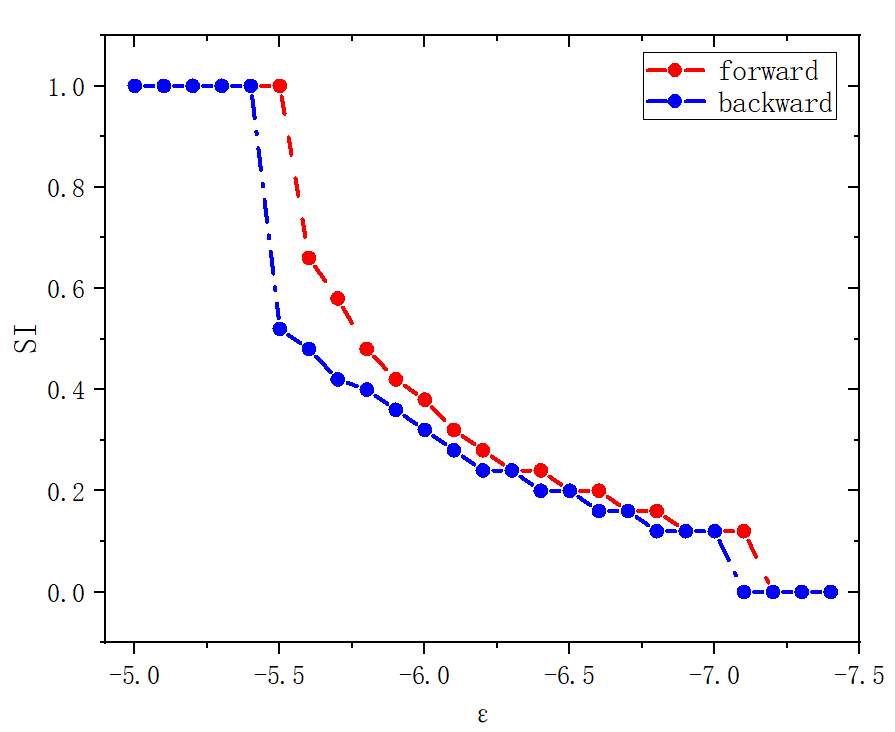
figure 9_B

figure 9_C

figure 9_D

figure 9_E

figure 9_F

figure 9_G

module Lorenz
implicit none
real,parameter :: h=0.01
integer,parameter :: MaxT=200300,T_trans=200000,N=3,M=100
real(kind=8) :: x(M,N)
integer :: p=35
integer,allocatable :: neighbour_matrix(:,:)
contains
subroutine x0()
implicit none
integer :: i
real :: x1,x2,x3
call random_seed()
do i=1,M,1
!call random_number(x1)
!call random_number(x2)
!call random_number(x3)
!x(i,1)=31.0*x1-14.0
!x(i,2)=44.0*x2-20.0
!x(i,3)=23.0*x3-1.0
read(20,*) x(i,1),x(i,2),x(i,3)
end do
end subroutine x0
subroutine fnf(xx,fx,i)
implicit none
real(kind=8) :: xx(N),fx(N)
integer :: t,j,i
real(kind=8) :: a,b,c,coupling,epsilon
coupling=0.0
epsilon=-7.0
do j=1,M,1
coupling=coupling+neighbour_matrix(i,j)*(x(j,1)-x(i,1))
end do
a=10.0
b=2.0
c=28.0
fx(1)=a*(xx(2)-xx(1))+(epsilon/real(2.0*p))*coupling
fx(2)=c*xx(1)-xx(1)*xx(3)-xx(2)
fx(3)=xx(1)*xx(2)-b*xx(3)
return
end subroutine fnf
subroutine rk4(x,t)
implicit none
integer :: i,j,t
real(kind=8) :: x(M,N),xx(N),fx(N)
real(kind=8) :: kx1(N),kx2(N),kx3(N),kx4(N)
do i=1,M,1
xx=x(i,:)
call fnf(xx,fx,i)
kx1=h*fx
xx=x(i,:)+0.5*kx1
call fnf(xx,fx,i)
kx2=h*fx
xx=x(i,:)+0.5*kx2
call fnf(xx,fx,i)
kx3=h*fx
xx=x(i,:)+kx3
call fnf(xx,fx,i)
kx4=h*fx
x(i,:)=x(i,:)+(kx1+2.0*kx2+2.0*kx3+kx4)/6.0
end do
return
end subroutine rk4
!max与min
subroutine Max_Min(xxx,max,min)
implicit none
real(kind=8) :: max(M),min(M),xxx(M)
integer :: i
do i=1,M,1
if(max(i)<xxx(i)) then
max(i)=xxx(i)
end if
if(min(i)>xxx(i)) then
min(i)=xxx(i)
end if
end do
return
end subroutine Max_Min
!建立网络矩阵
subroutine neighbour(K)
implicit none
integer :: K !单节点K个邻居
integer :: i,j,number
allocate(neighbour_matrix(M,M))
!初始化网络矩阵
neighbour_matrix=0
do i=1,M-1,1
do j=i+1,M,1
if(abs(i-j)<=K/2.or.abs(i-j)>=M-K/2) then
neighbour_matrix(i,j)=1
neighbour_matrix(j,i)=1
end if
end do
end do
!输出矩阵
do i=1,M,1
do j=1,M,1
write(10,"(I2)",advance='no') neighbour_matrix(i,j)
end do
write(10,*)
end do
return
end subroutine neighbour
end module Lorenz
program main
use Lorenz
implicit none
integer :: i,j,t
real(kind=8) :: max(M),min(M)
open(10,file="neighbour_matrix.txt")
open(20,file="x0.txt")
open(30,file="c_M_max_min.txt")
open(40,file="t_x_y_z_14.txt")
open(50,file="t_x_y_z_15.txt")
open(60,file="i_t_x_y_z.txt")
open(70,file="i_t_x_y_z_kuaizhao.txt")
open(80,file="i_t_x_y_z_all.txt")
max=-10000.0
min=10000.0
call x0()
call neighbour(2*p)
do t=1,MaxT,1
call rk4(x,t)
if(t>T_trans) then
call Max_Min(x(:,1),max,min)
write(40,"(4(F15.6))") (t-T_trans)*h,x(14,1),x(14,2),x(14,3)
write(50,"(4(F15.6))") (t-T_trans)*h,x(15,1),x(15,2),x(15,3)
do i=1,M,1
write(80,"(5(F15.6))") real(i),(t-T_trans)*h,x(i,1),x(i,2),x(i,3)
if(t-1==T_trans) then
write(70,"(5(F15.6))") real(i),(t-T_trans)*h,x(i,1),x(i,2),x(i,3)
end if
if(mod(t,50)==0) then
write(60,"(5(F15.6))") real(i),(t-T_trans)*h,x(i,1),x(i,2),x(i,3)
end if
end do
end if
end do
do j=1,M,1
write(30,*) j,max(j),min(j)
end do
end program main


